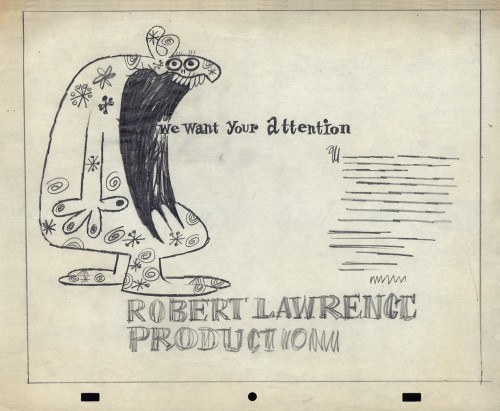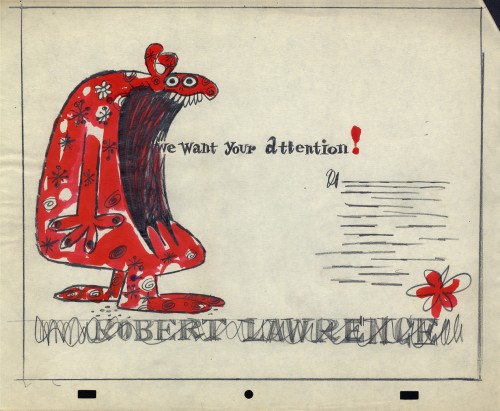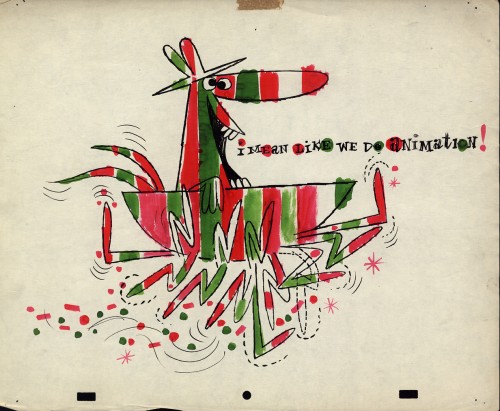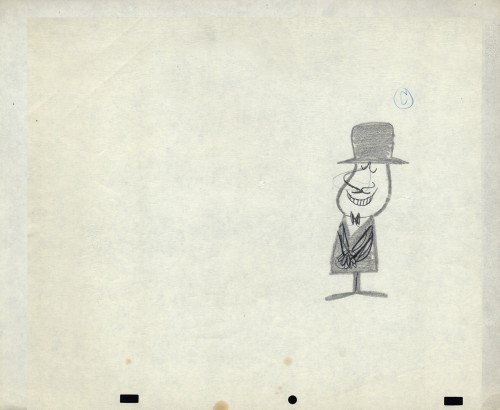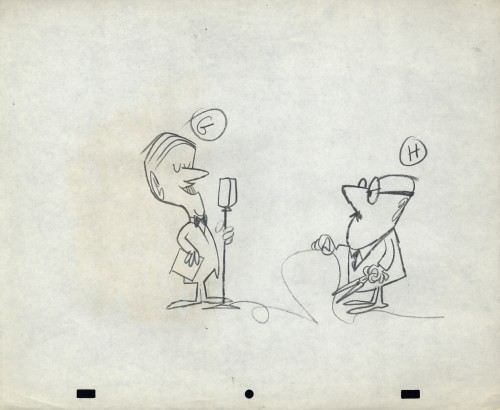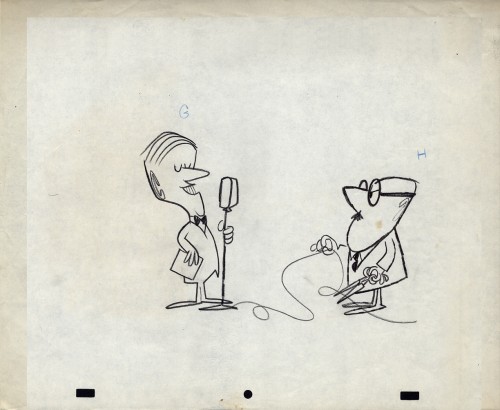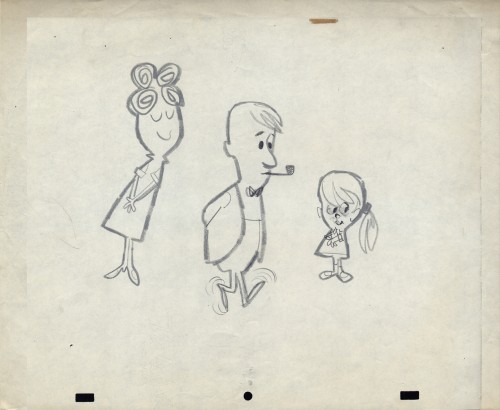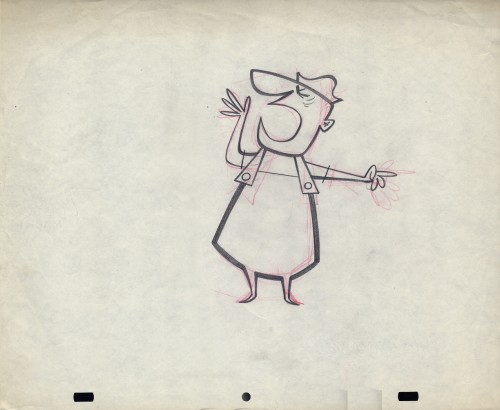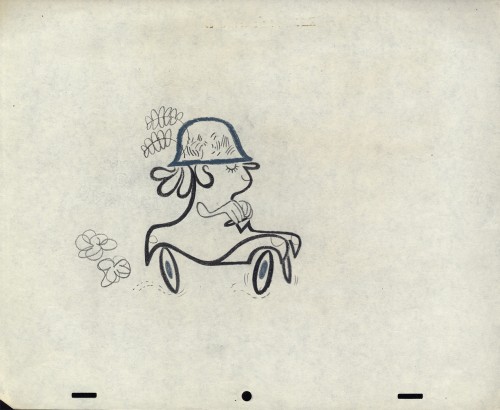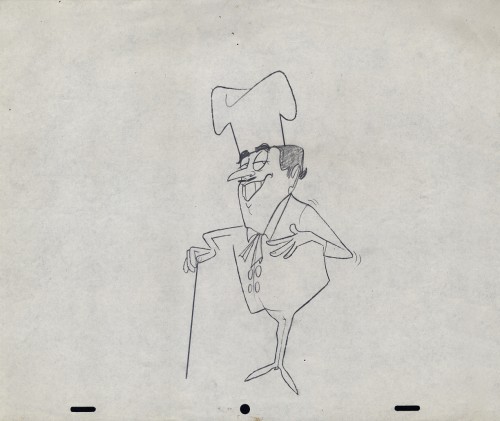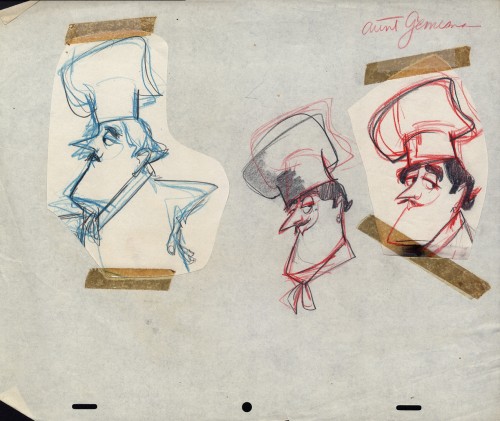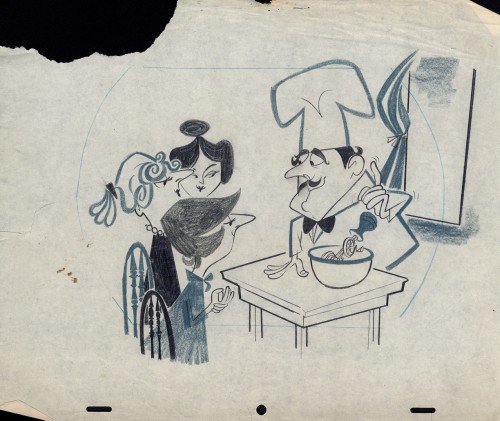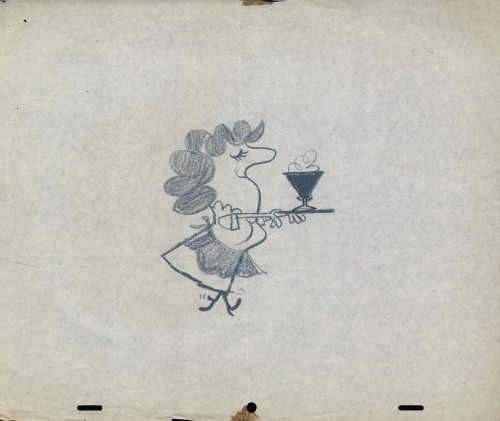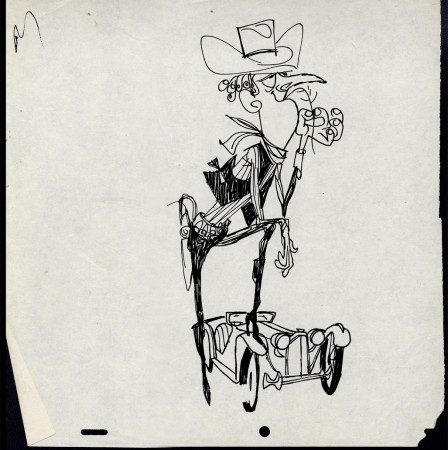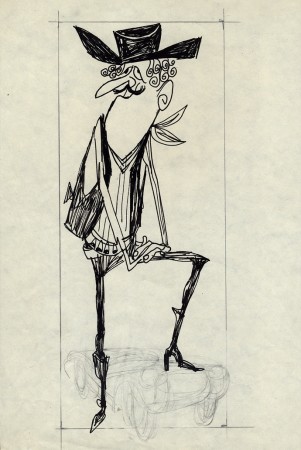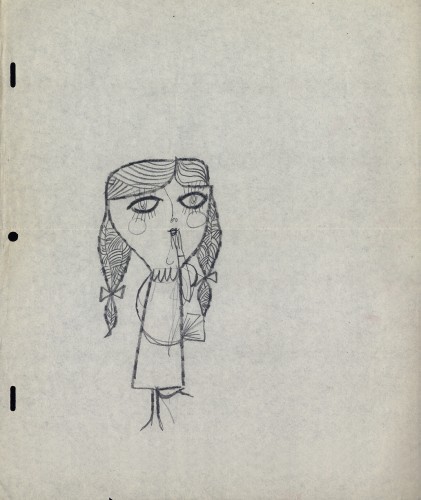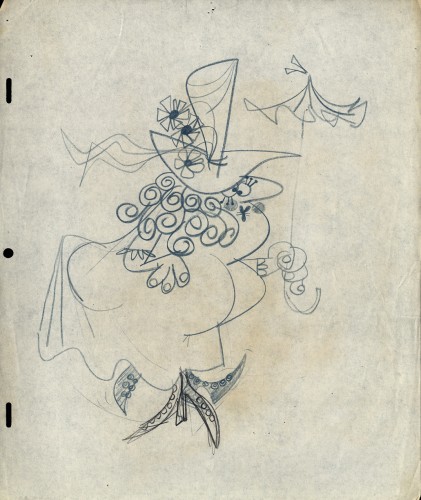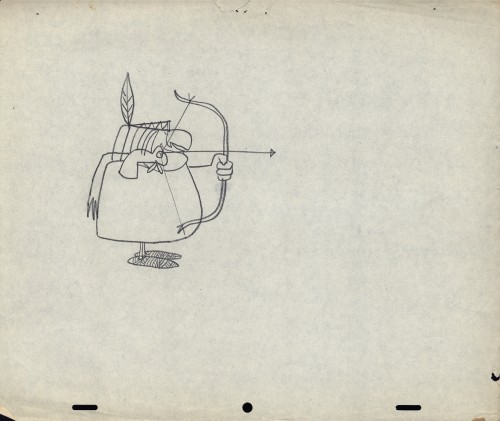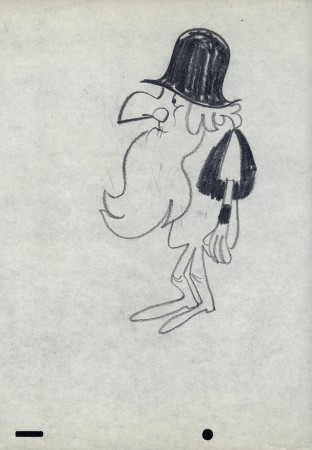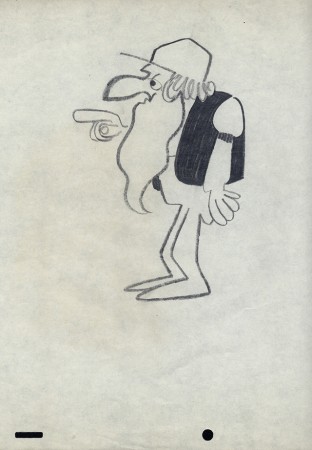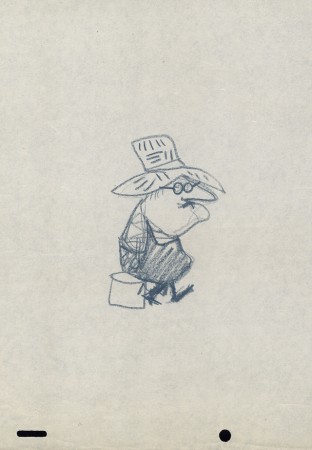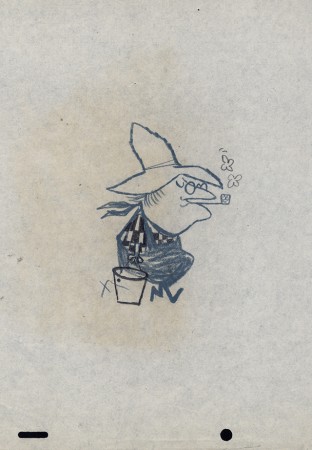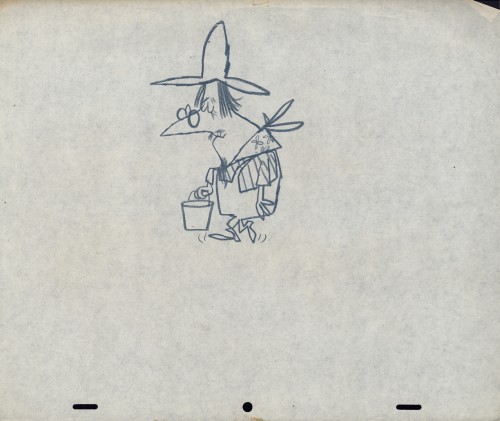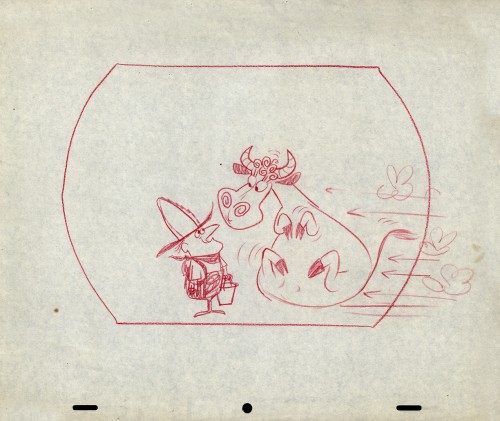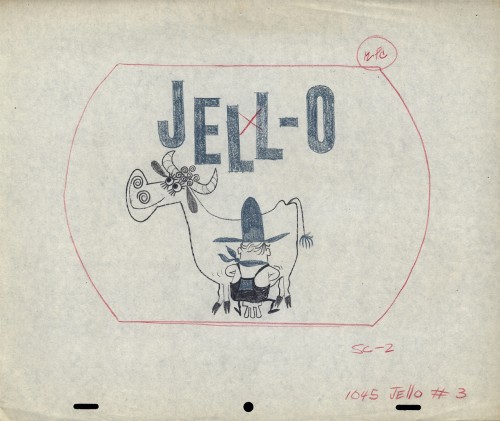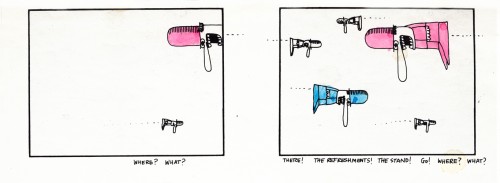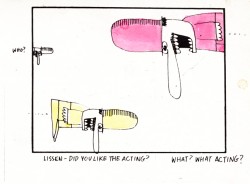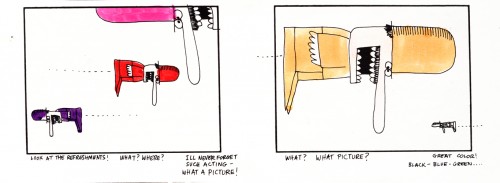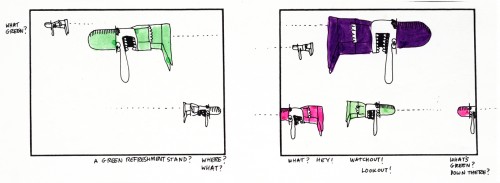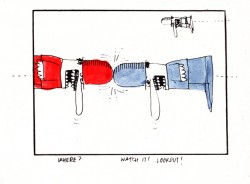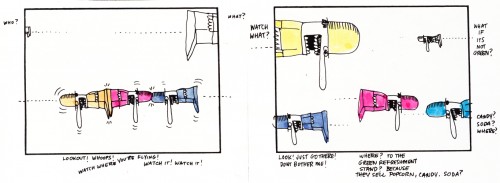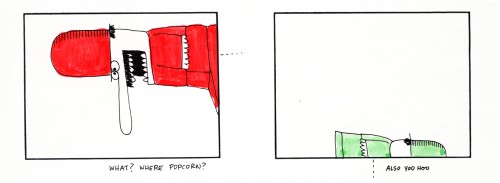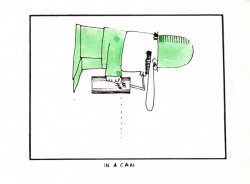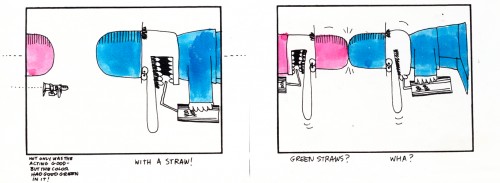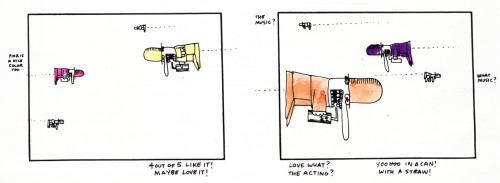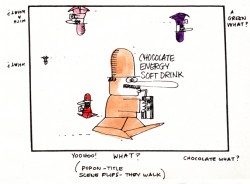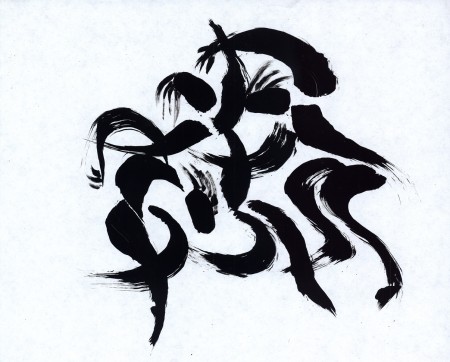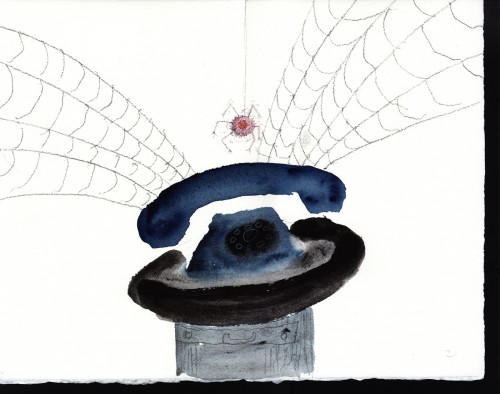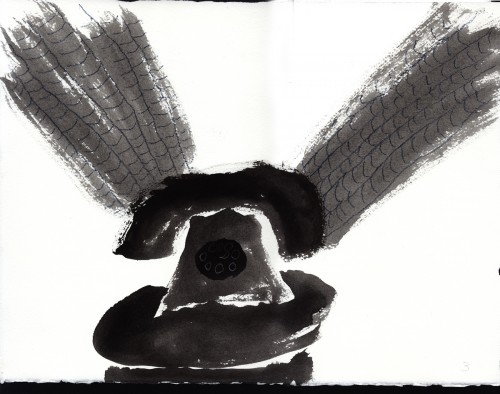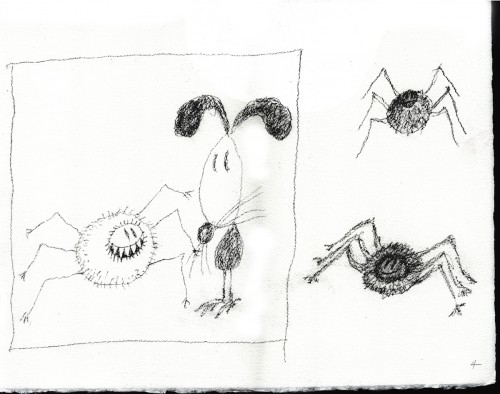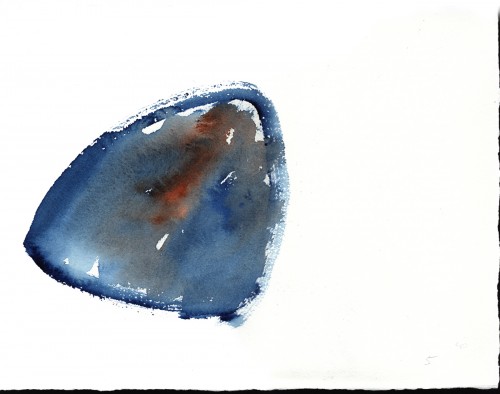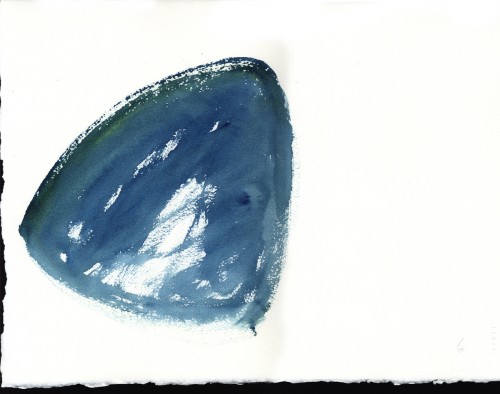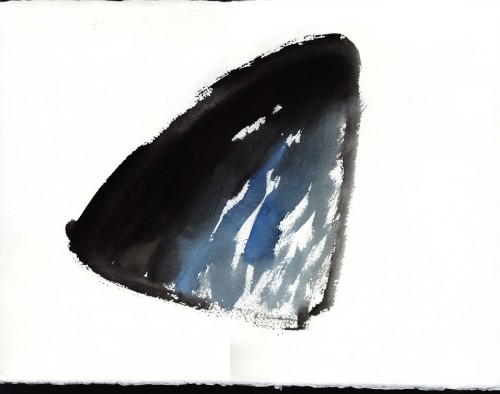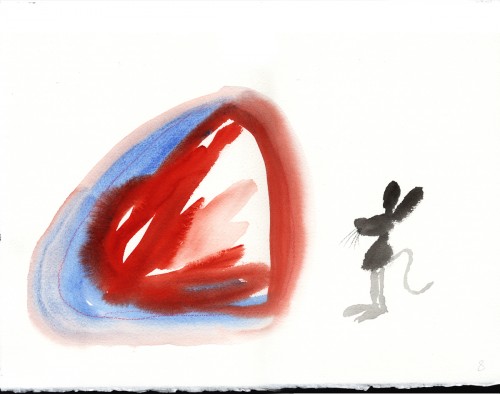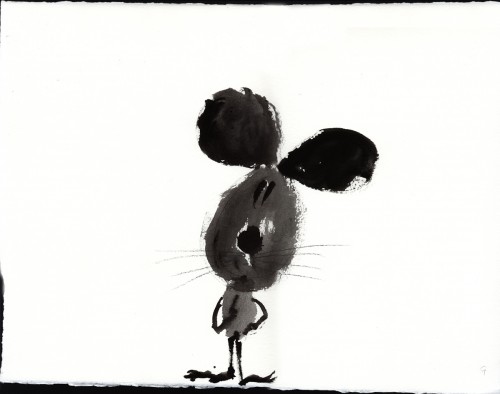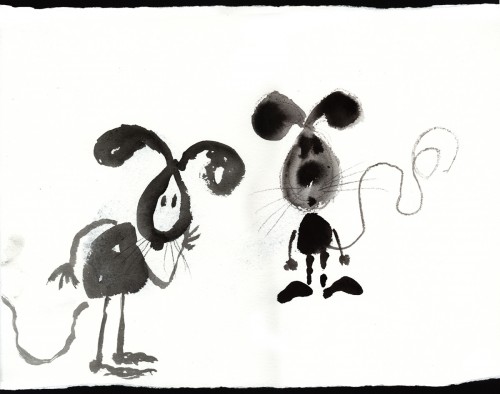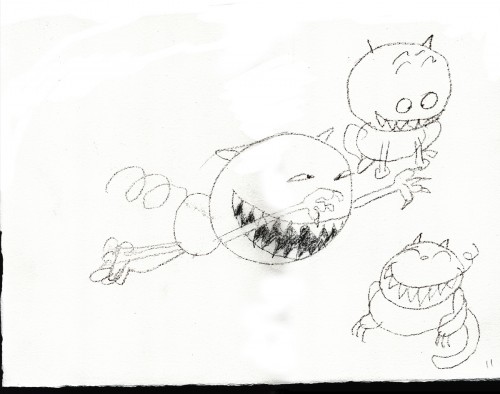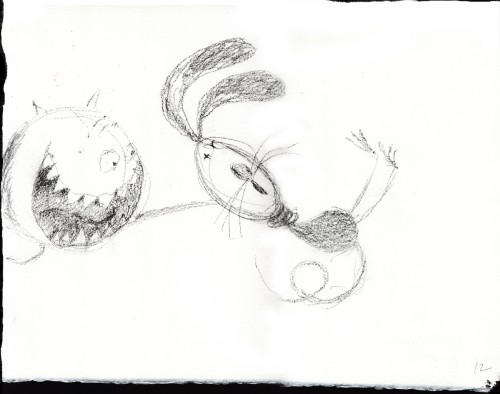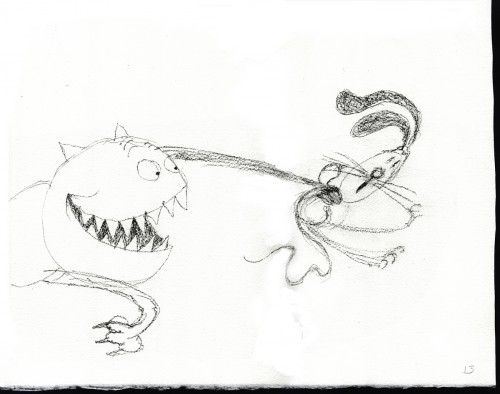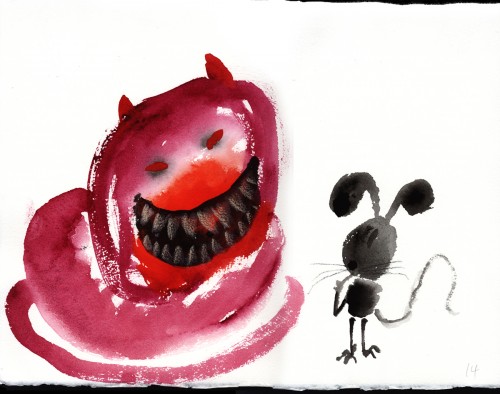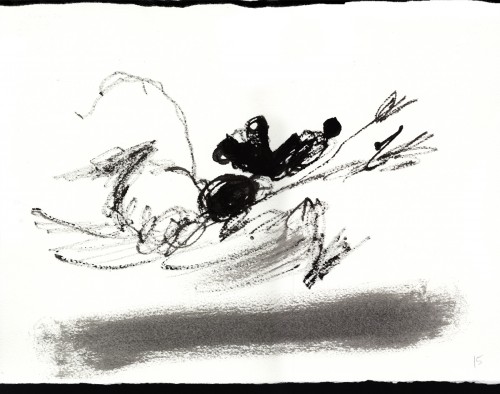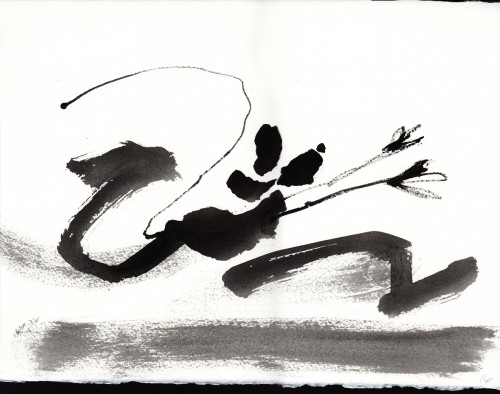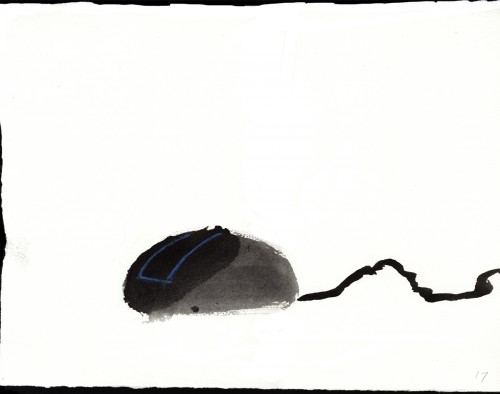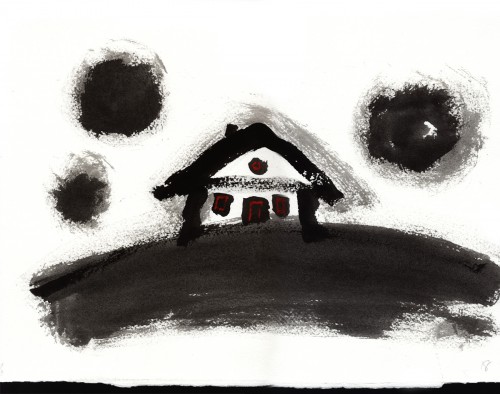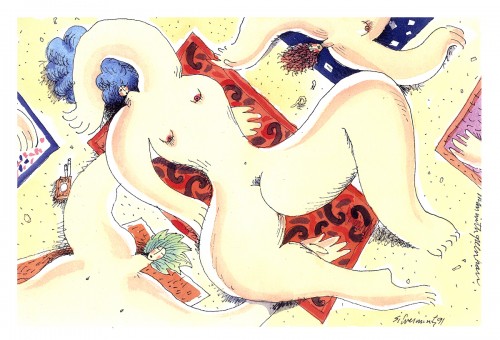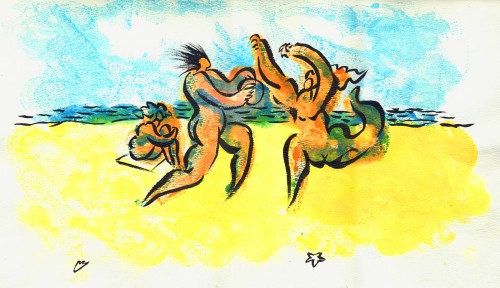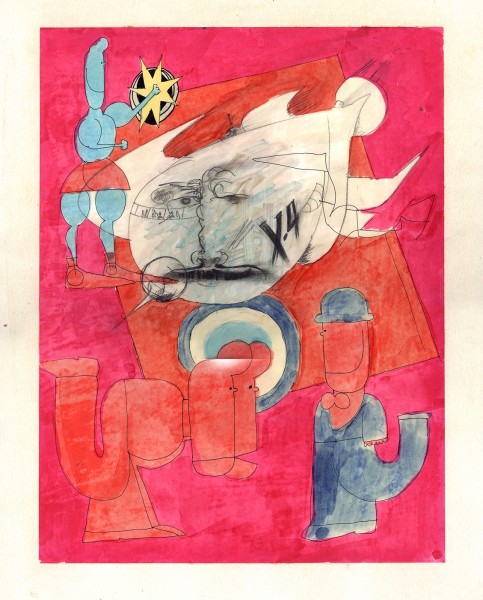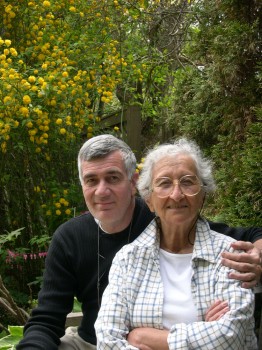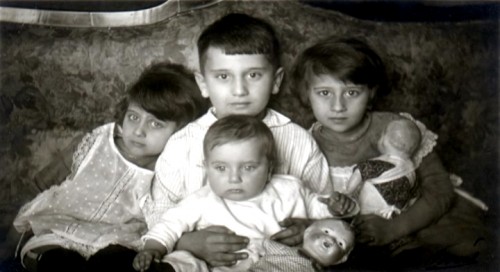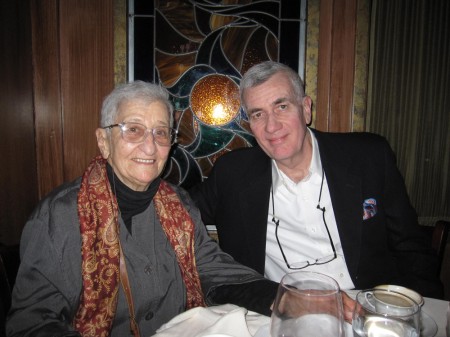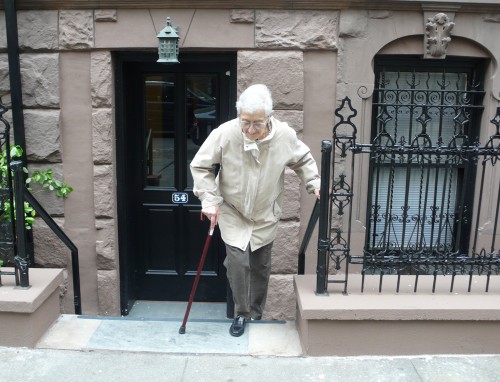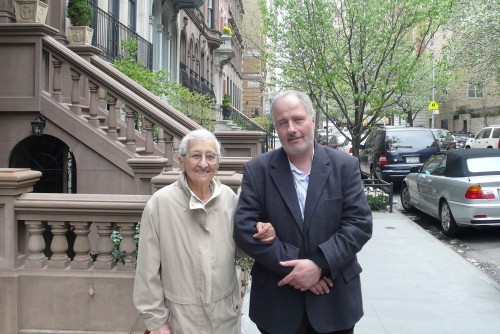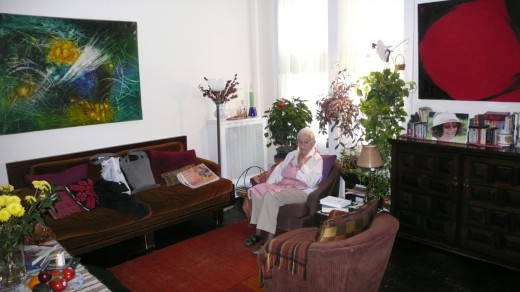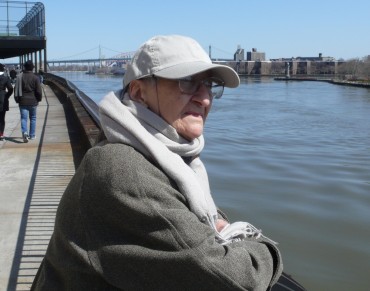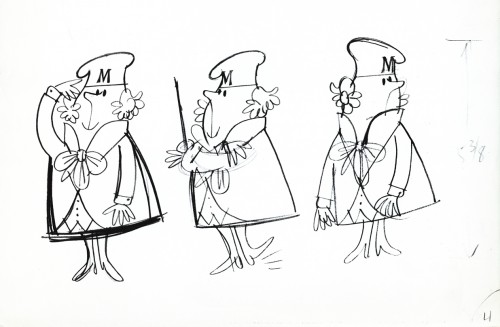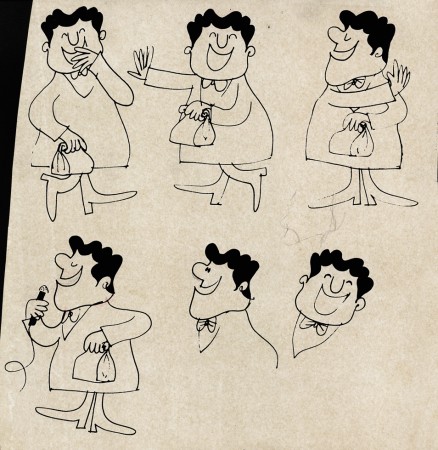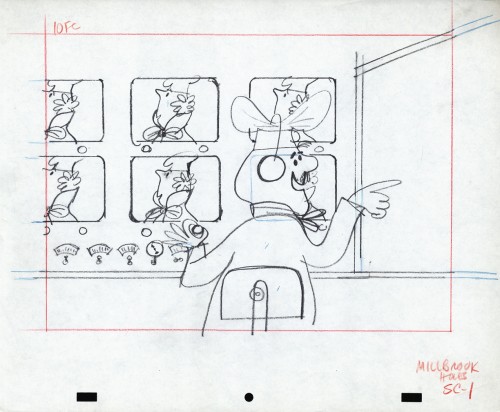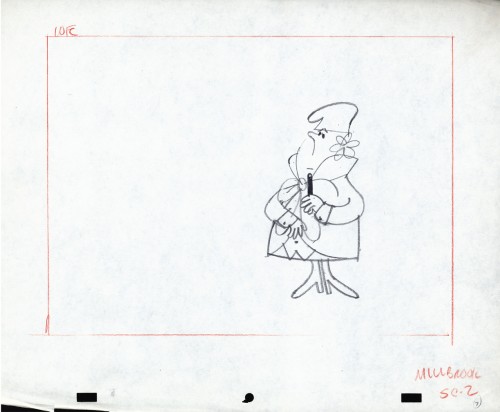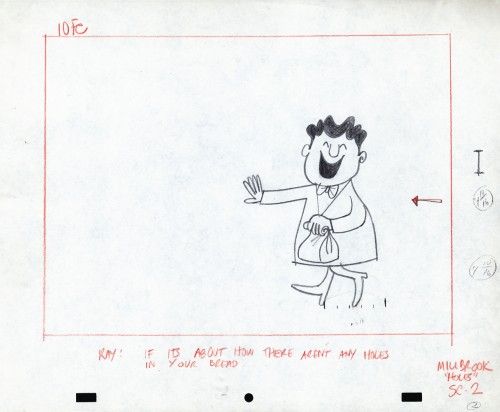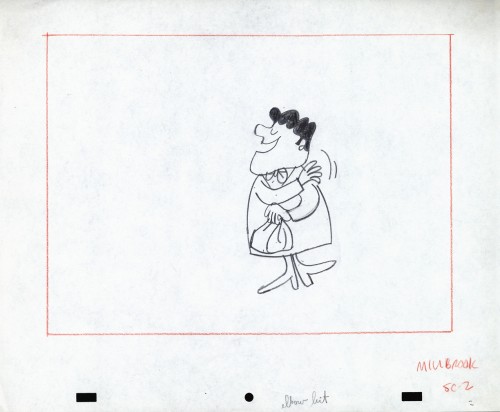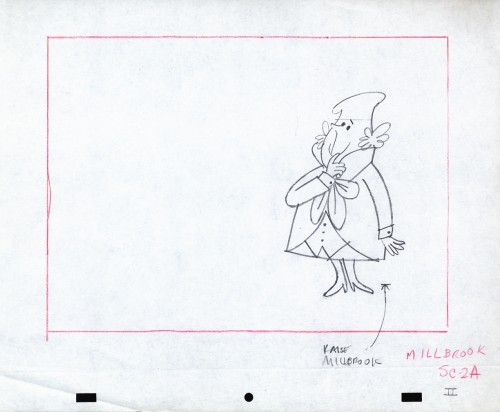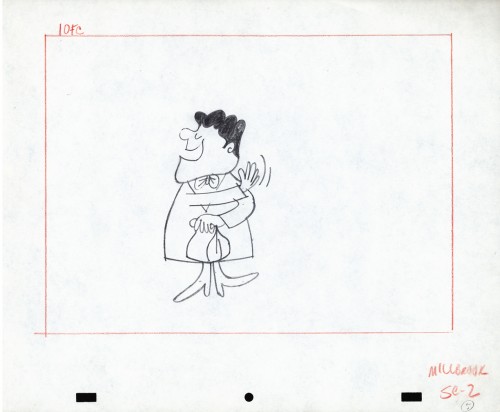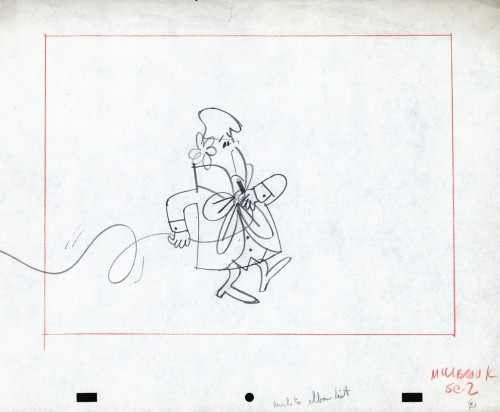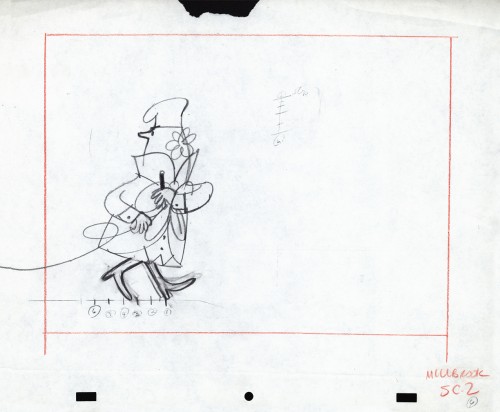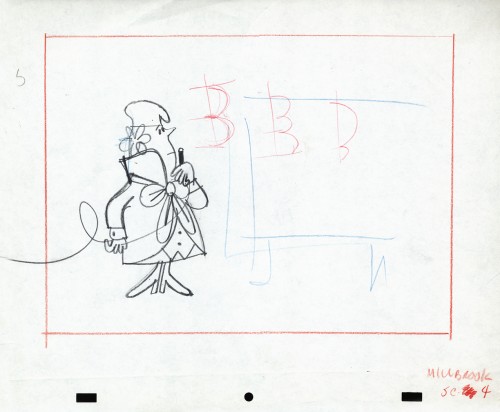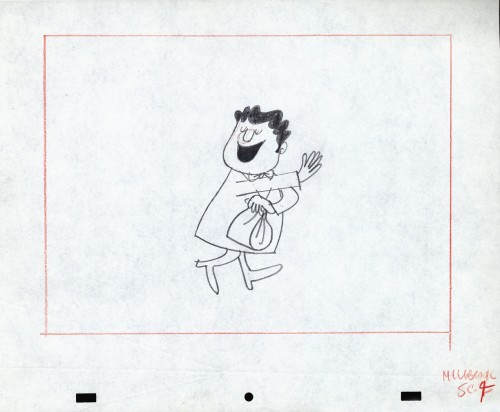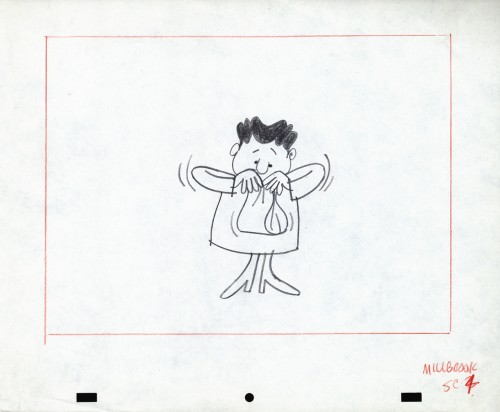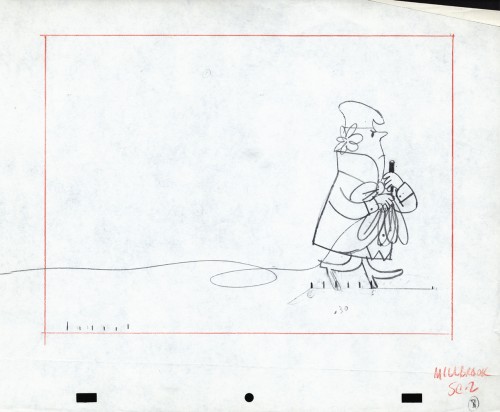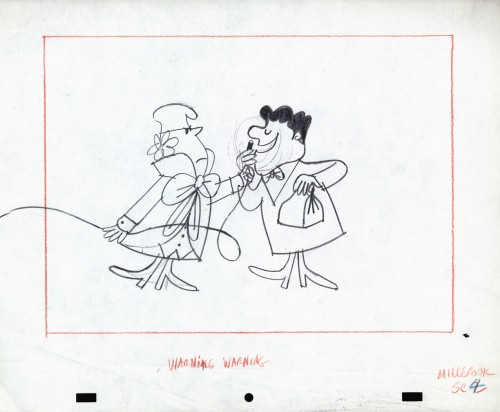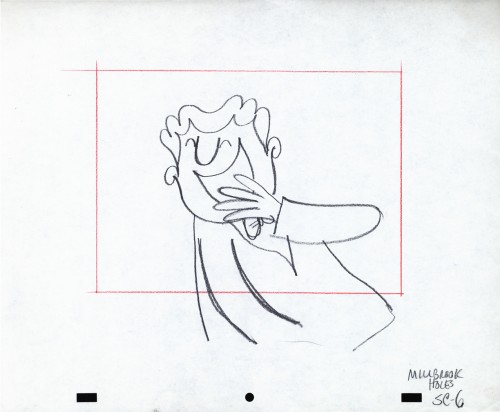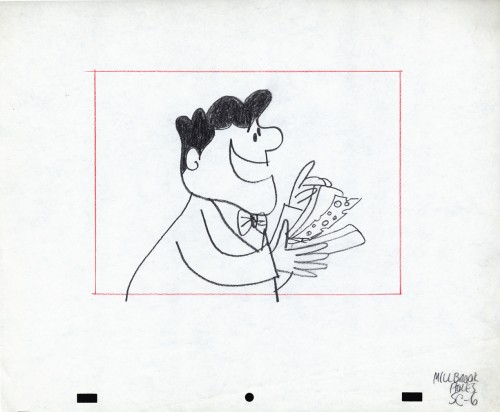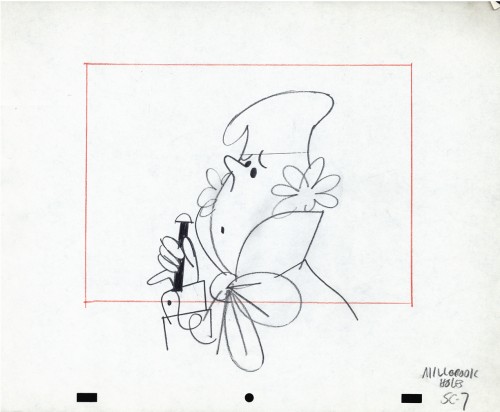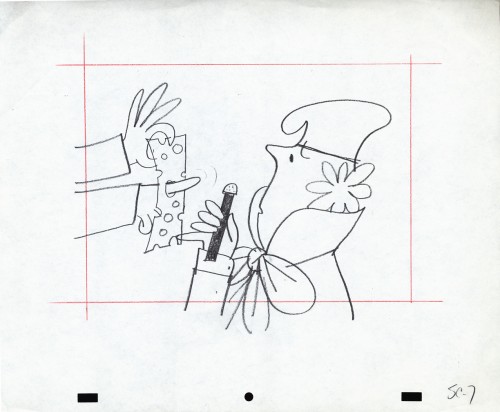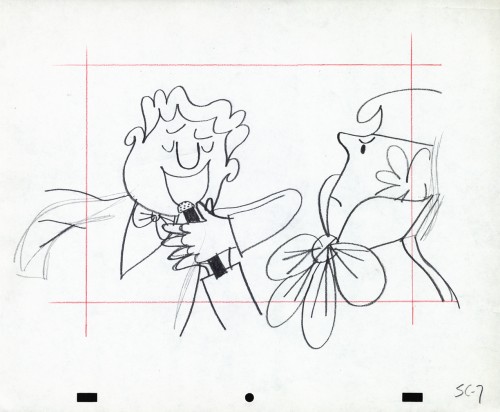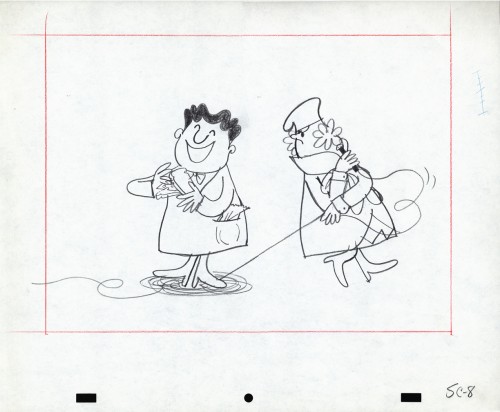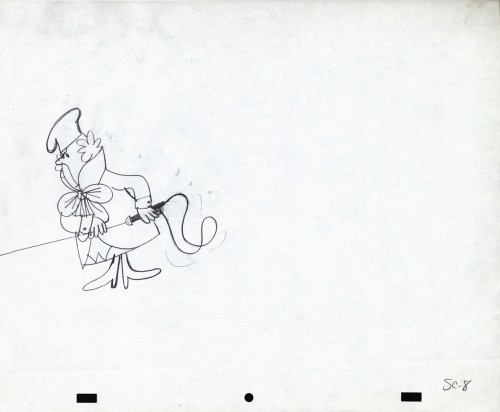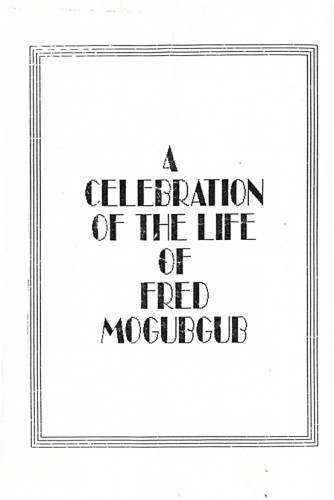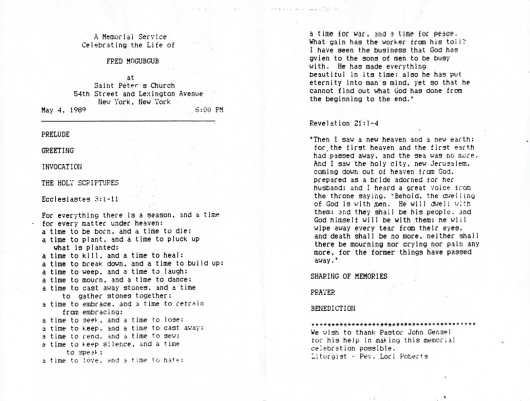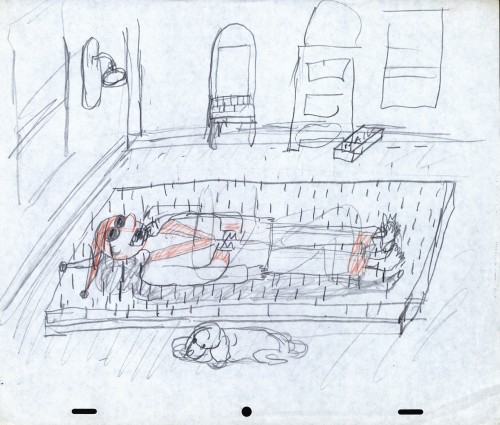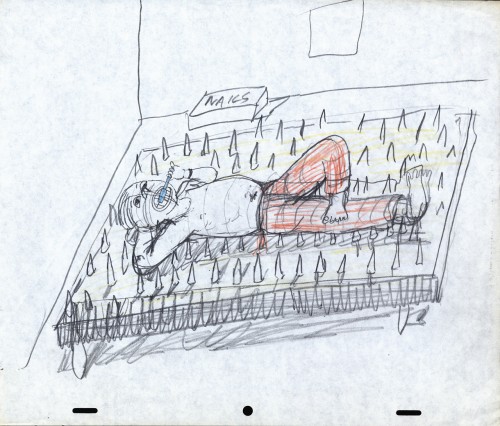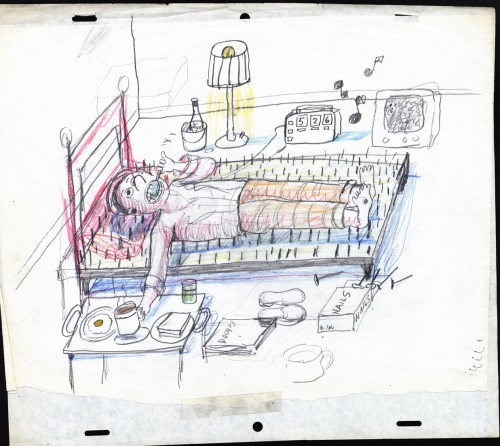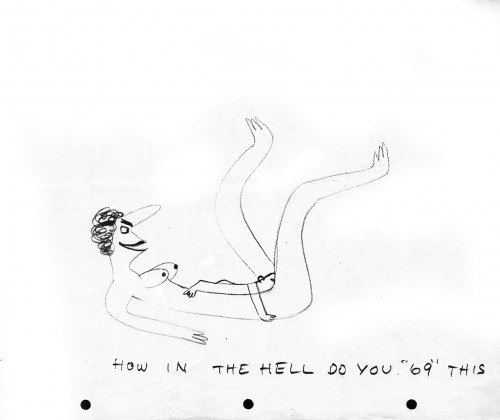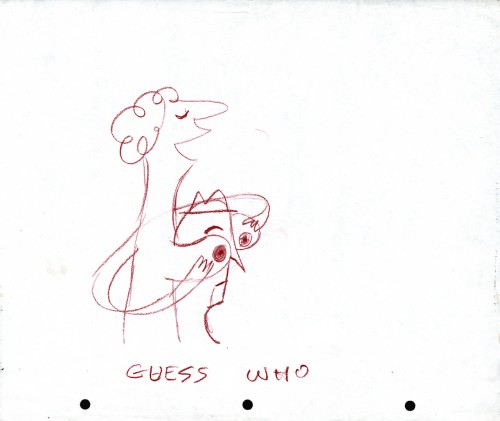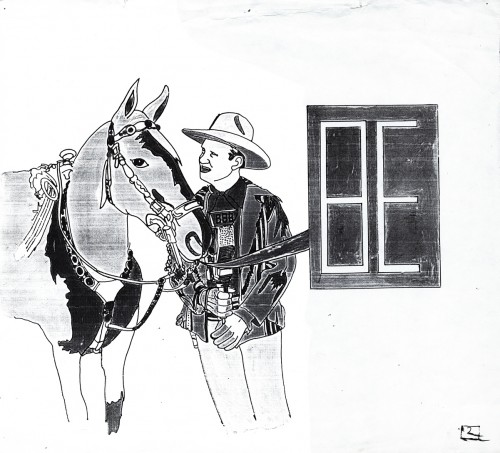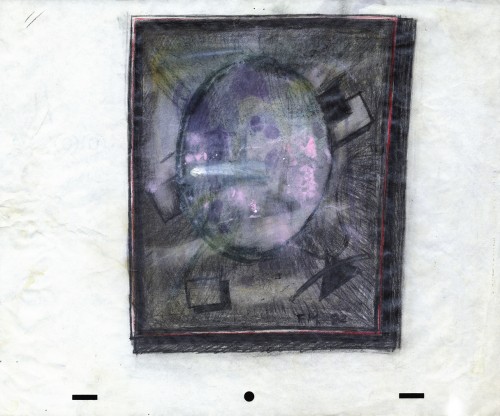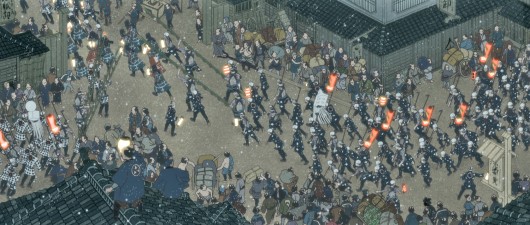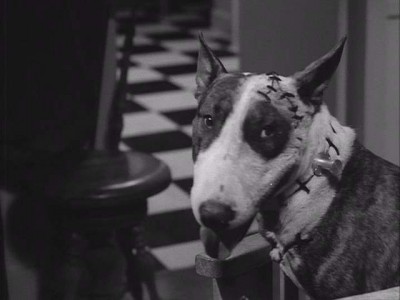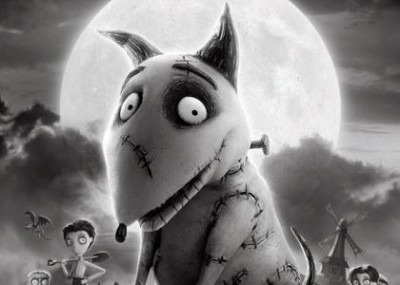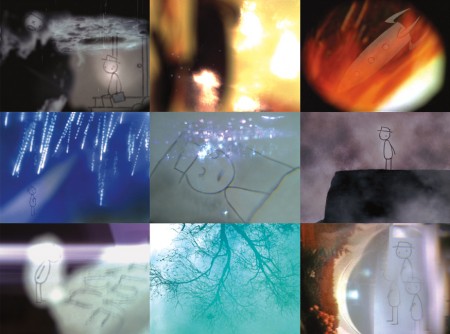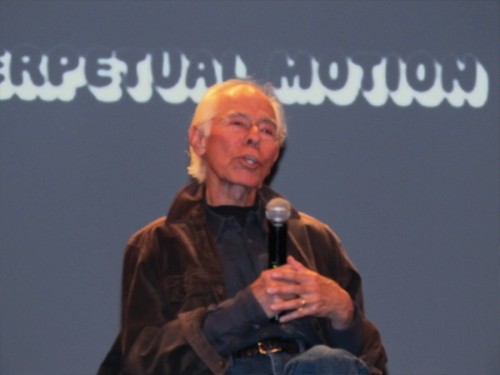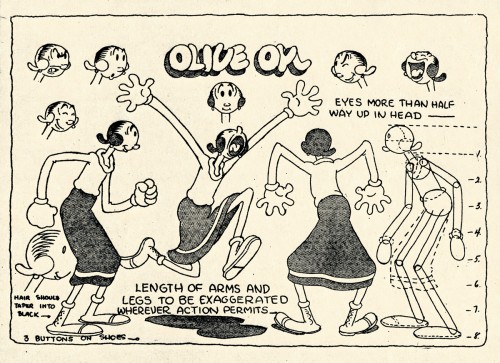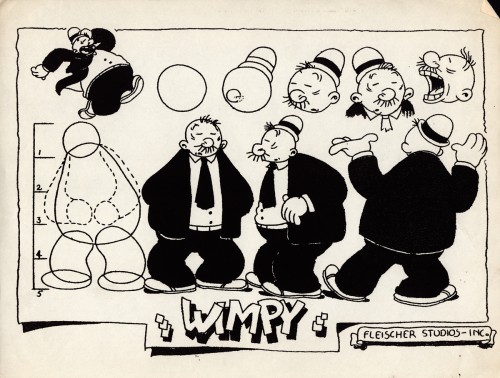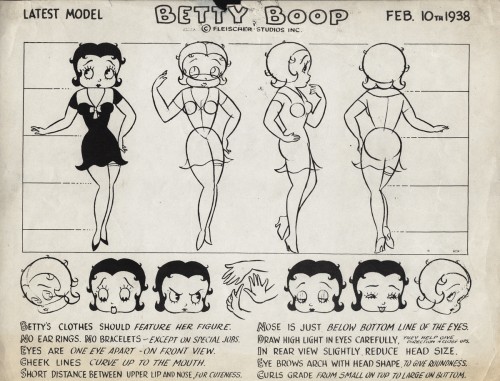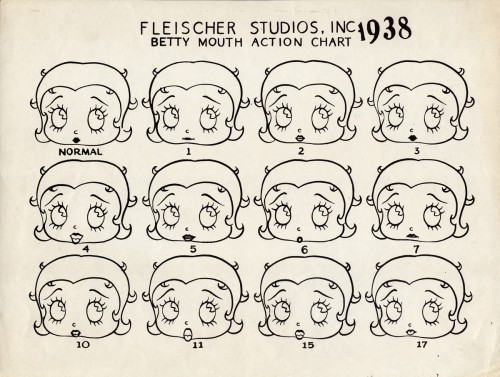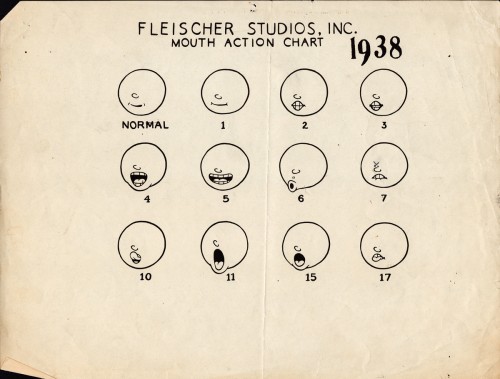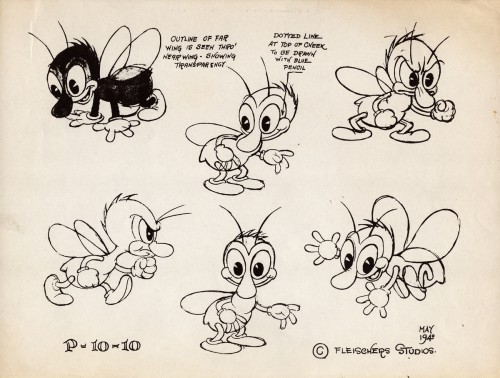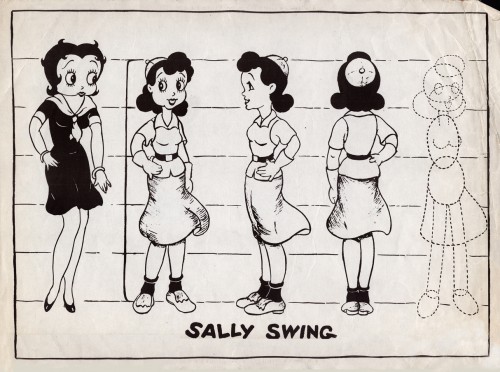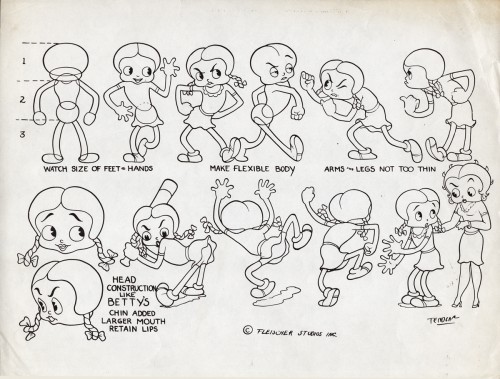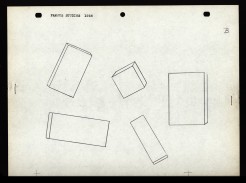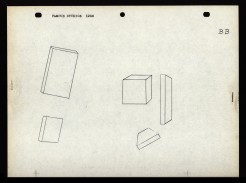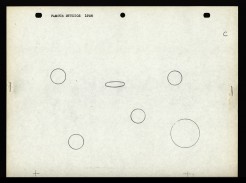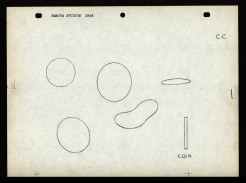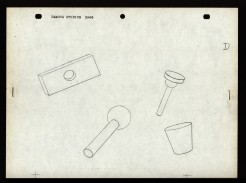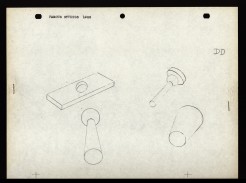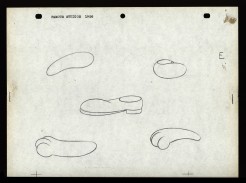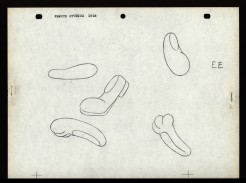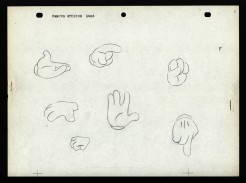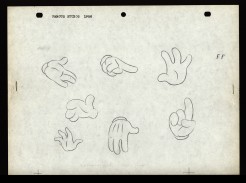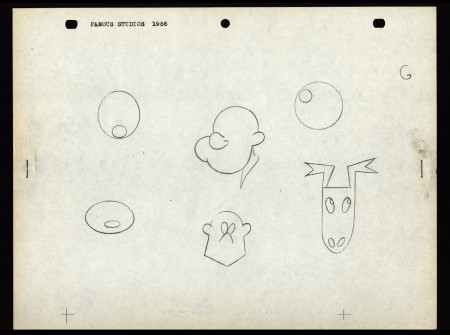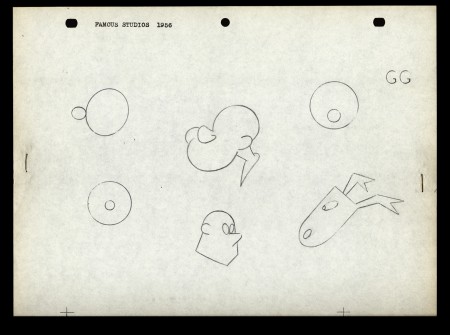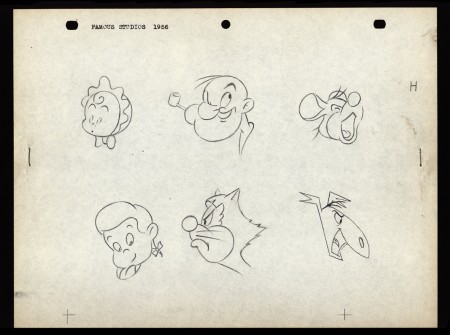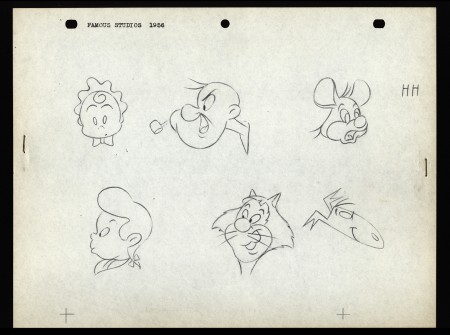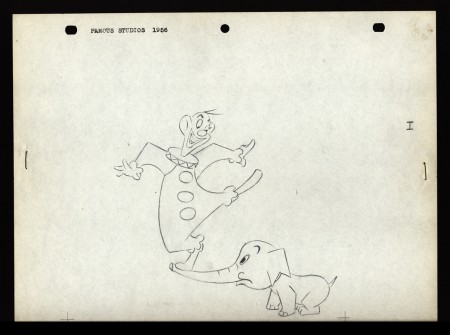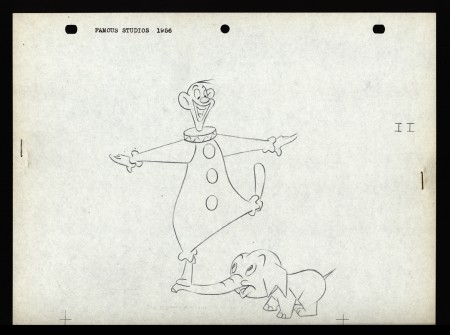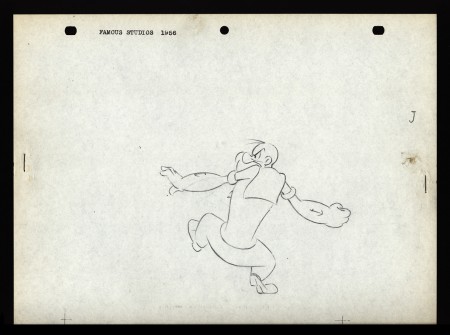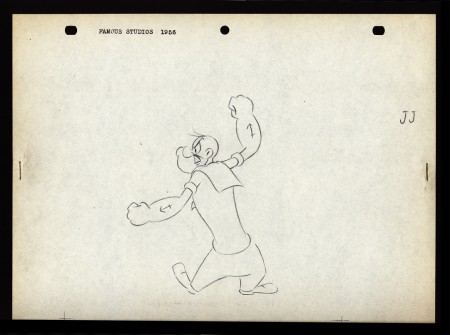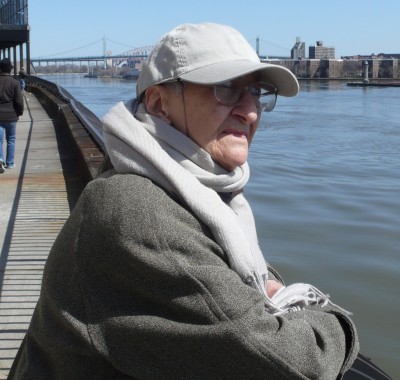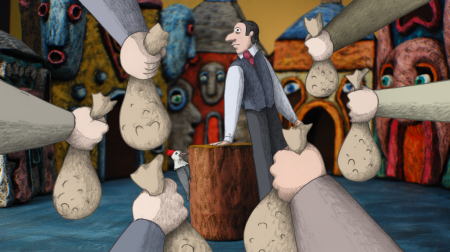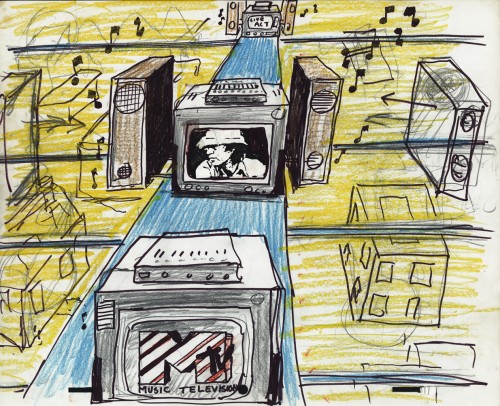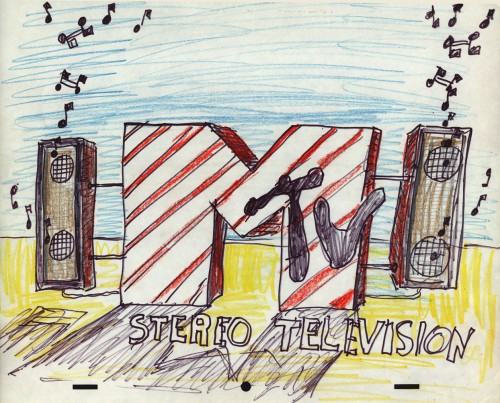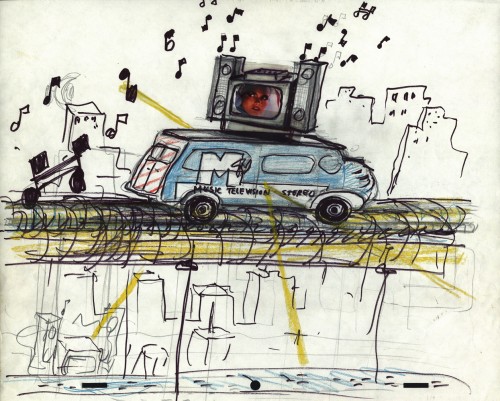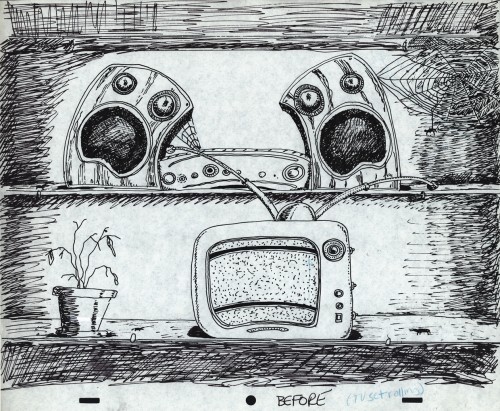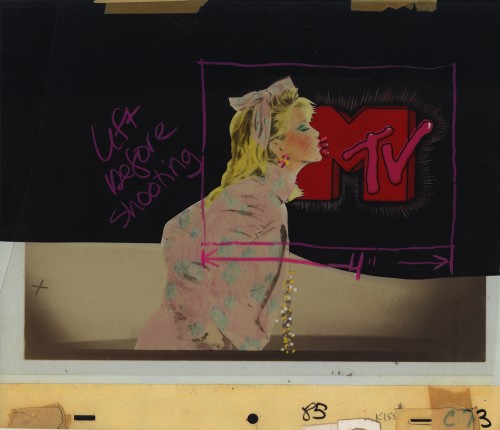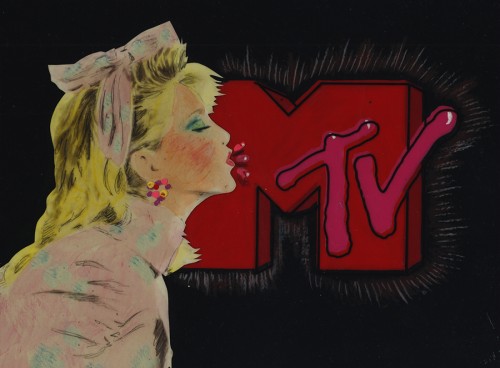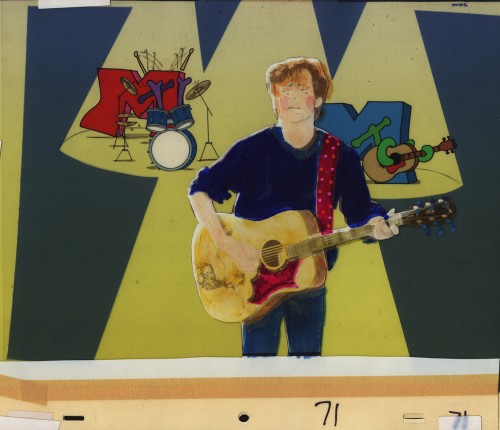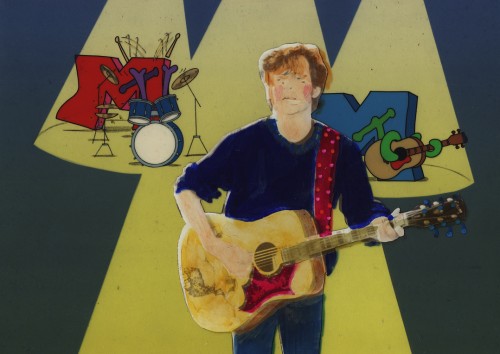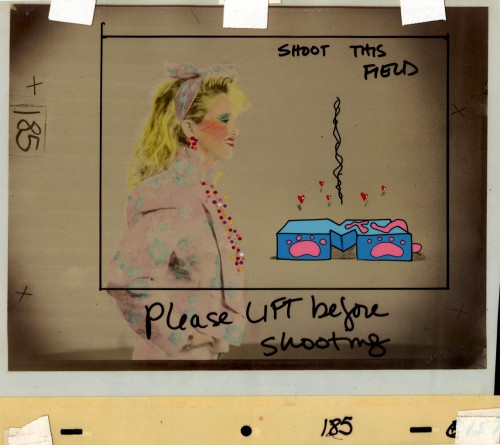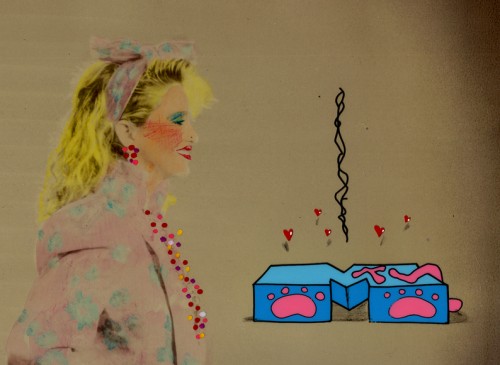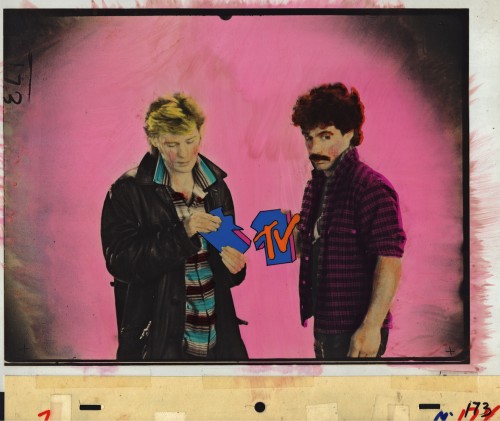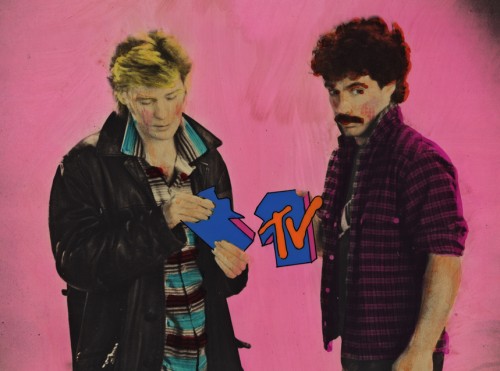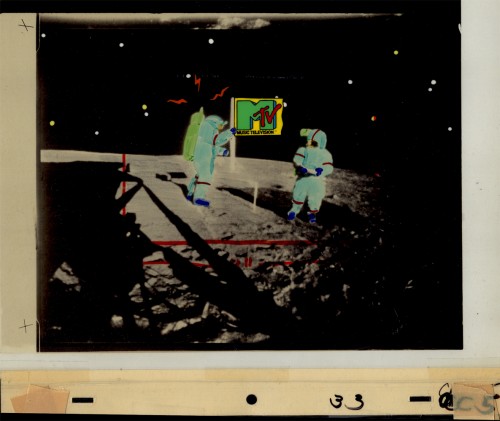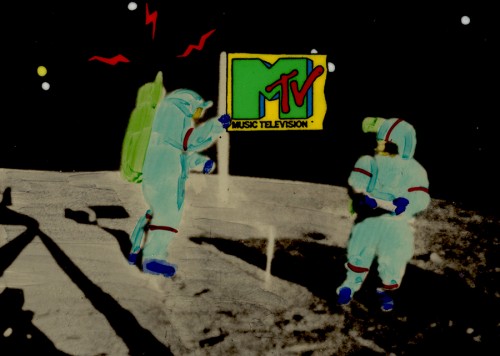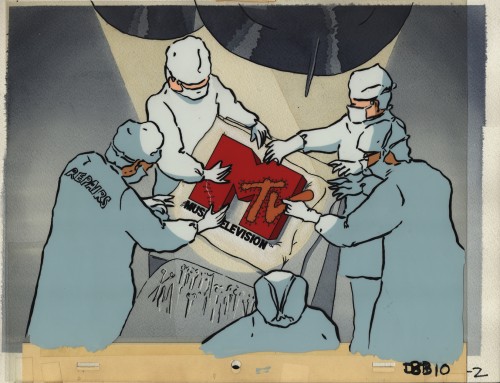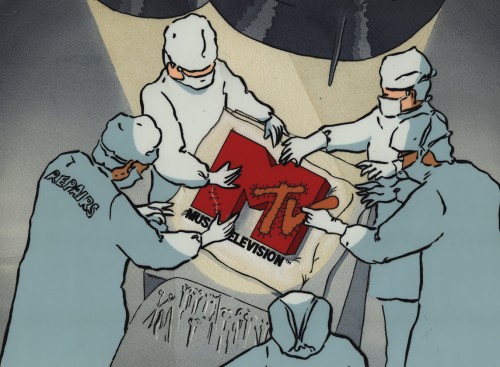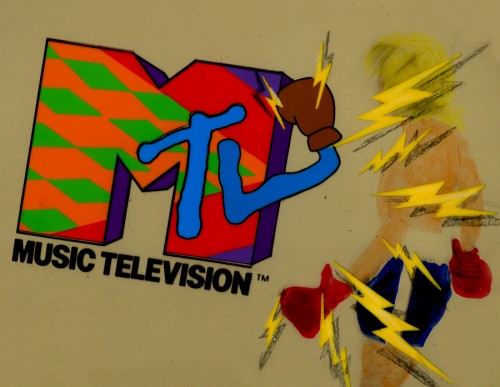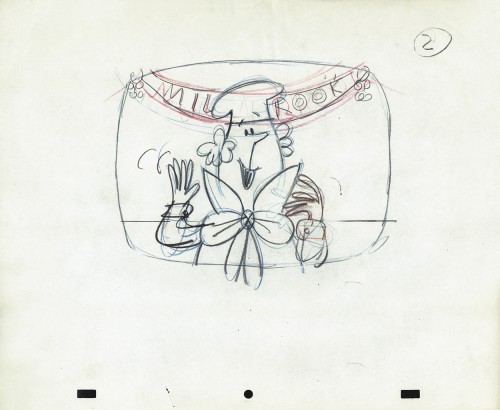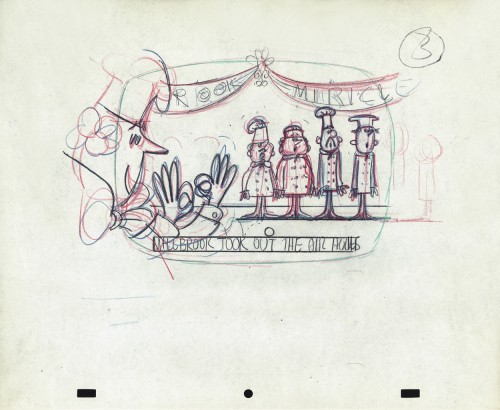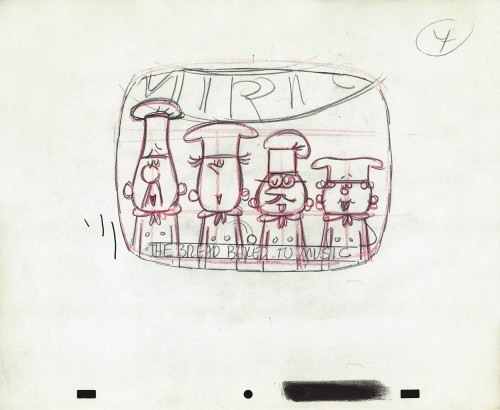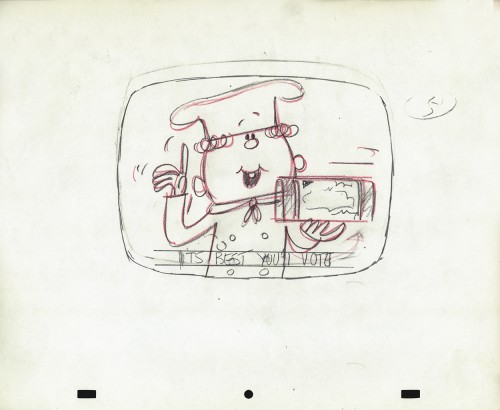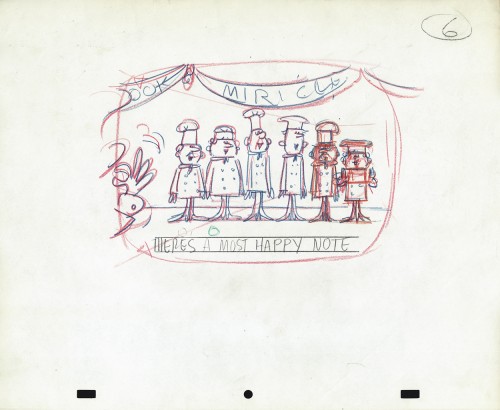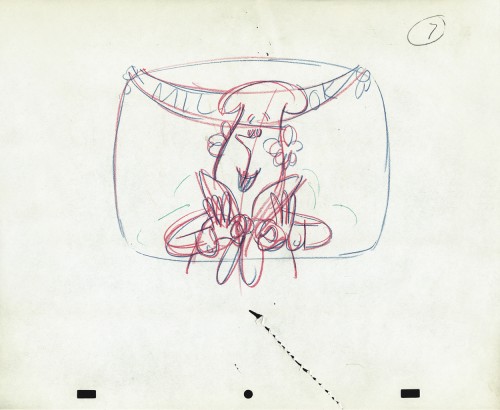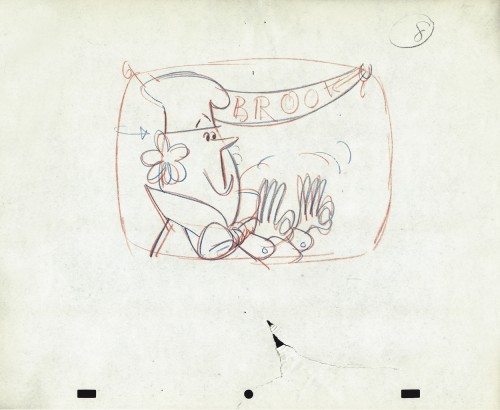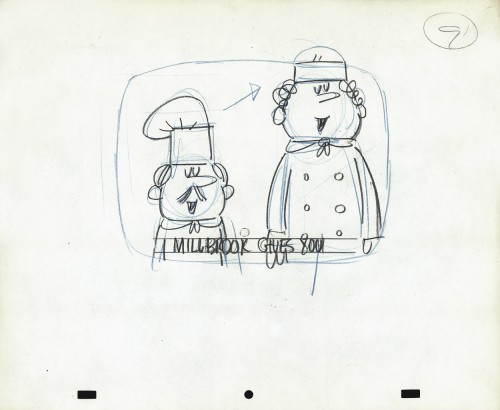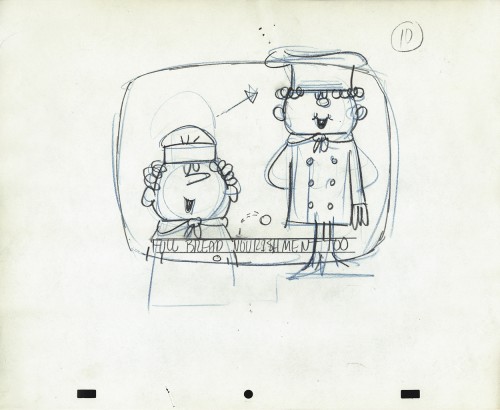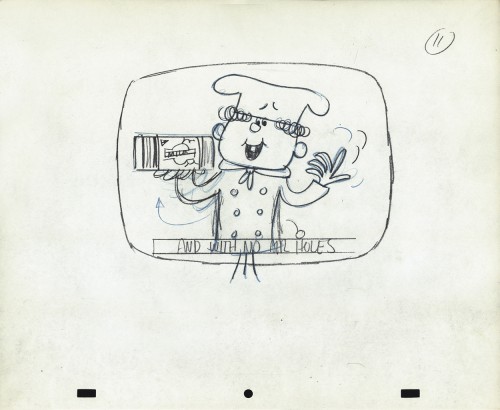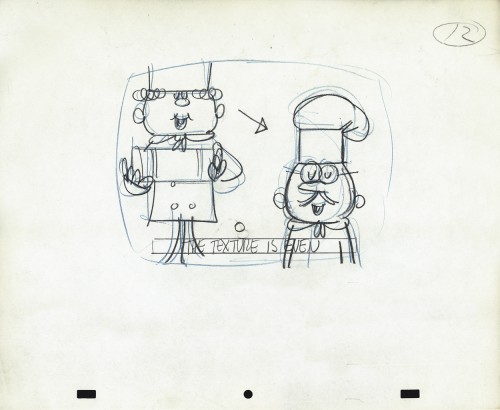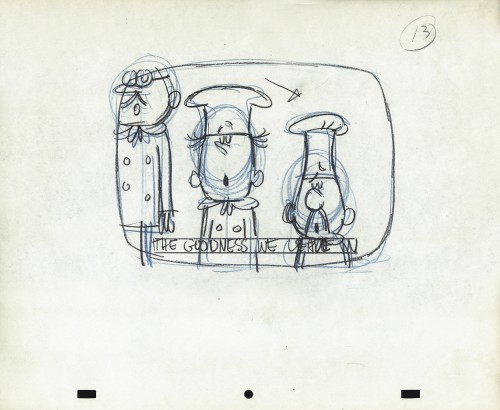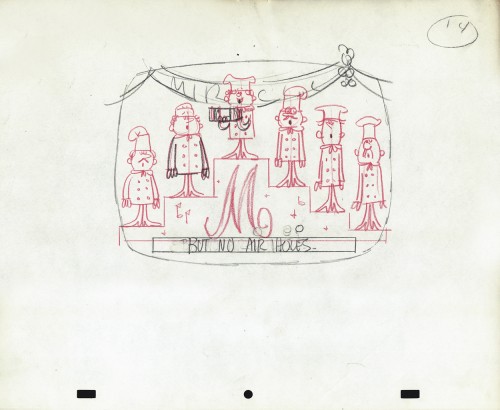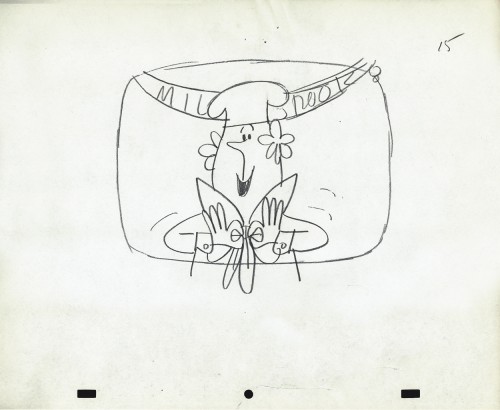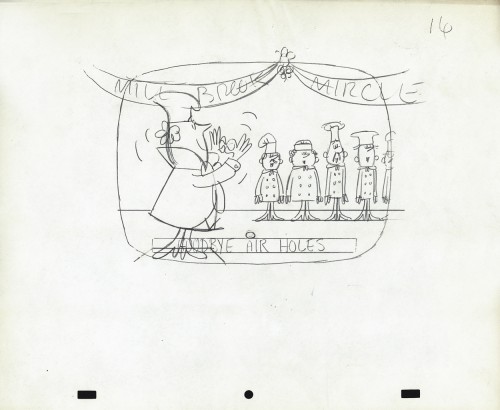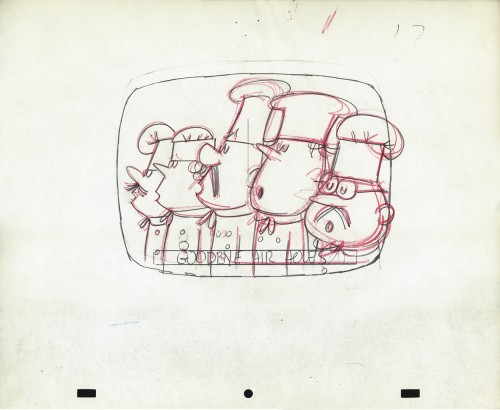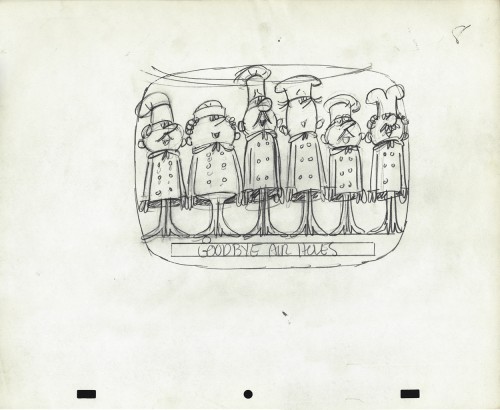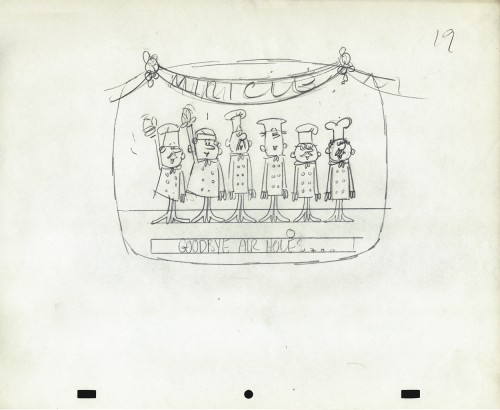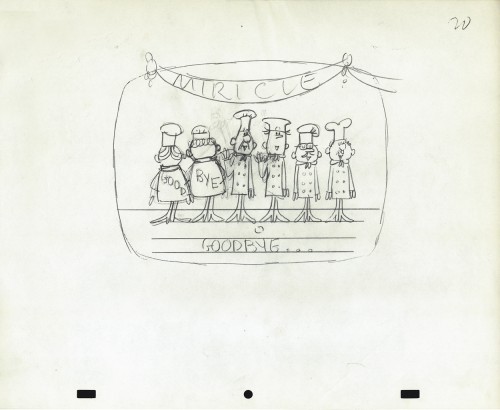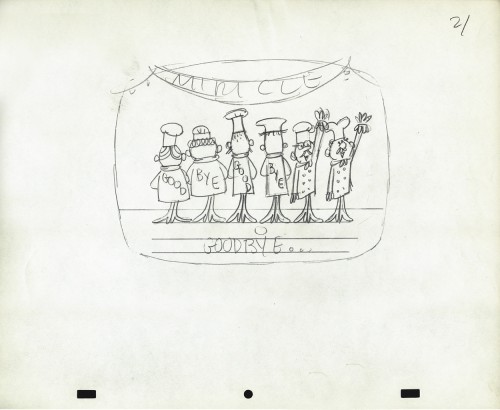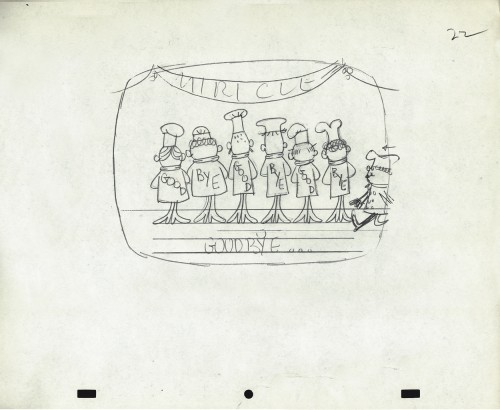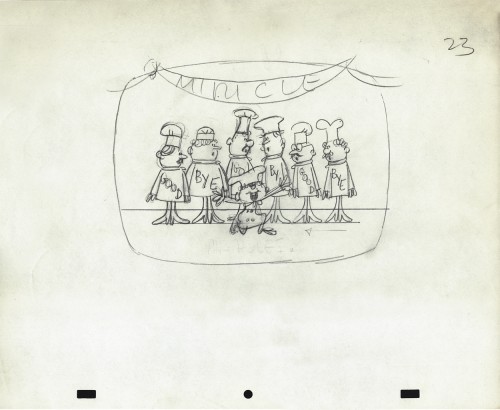Search ResultsFor "cafarelli"
Animation Artifacts &commercial animation &Layout & Design &Models &UPA 21 Nov 2012 06:56 am
Robert Lawrence Prods. – part 1
- Robert Lawrence Productions was a thriving studio in New York in the days post-UPA. Many of the animators moved from UPA, once they closed, to Robert Lawrence. Grim Natwick/Tissa David worked there (freelance), Lu Guarnier/Vince Cafarelli worked there, and consequently, Vince collected a lot of artwork from the spots he did. This post features a lot of that artwork. You’ll see how great the design and styling was at the studio, even though I don’t know what clients or sonsors they were done for. The designers certainly took off where UPA left off.
But first, let me share two in-house studio gags done at UPA.
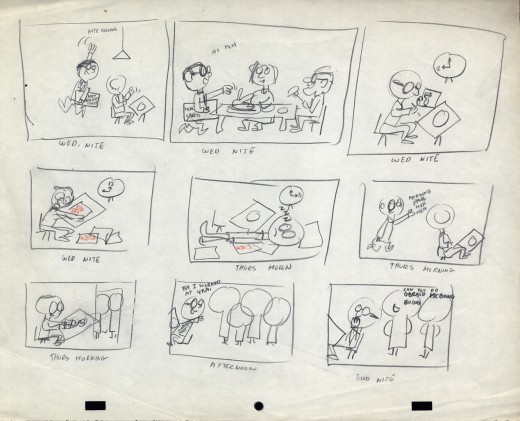 1
1
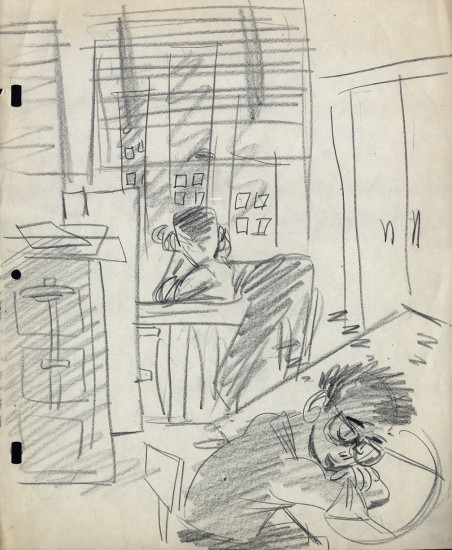 2
2
At UPA – NY, Lu Guarnier was the only animator
who had a window. Vince Cafarelli and Pablo Ferro
were Lu’s Assistants/Inbetweeners, so they also
had the luxury of a window.
- OK, now onto Robert Lawrence. The more I look into this company’s work the more impressed I am. The quality of designers and animators on board was extraordinarily high. I have a lot of Layouts for films that are completely lost. I’m not sure what most of the images are for or what the stories of the spots was. I just have drawings, and most of them are impressive, even more so in some ways than much of the UPA work I’ve seen.
So let’s take a look.
First there is the promo art. As an introduction to the company, here are four self-promo pieces that were used as trade ads for the company.
I’ve assumed that these images were created for a print ad in some magazine or another. There are three of them; one comes in a 2-color version.
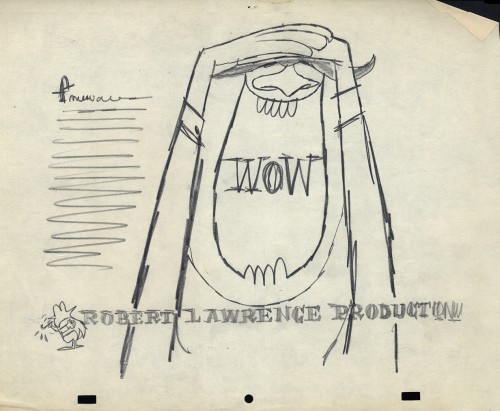 1
____________________________
1
____________________________Now we get into some of the fun stuff. Here are the layouts done in a million styles, all beautifully drawn and designed. I feel like I want to say thank you to some of the artists involved. If only I knew who the artists were. The drawings and cels were all done on paper with a “Signal Corps” hole-punch. (Looks like Oxberry, but the center hole is the same diameter thickness as the square pegs.)
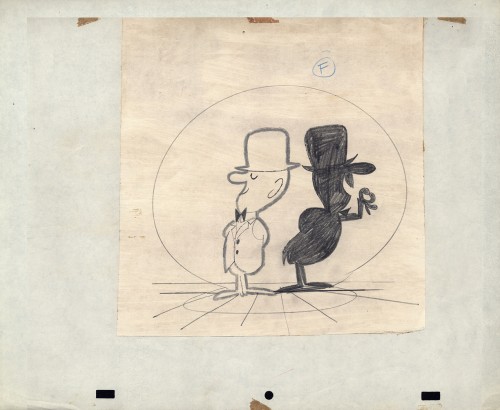 1
1This is a beautiful gag told a million times,
but done perfectly in this drawing.
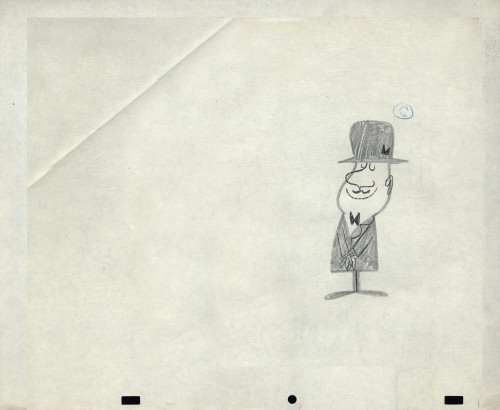 3
3
The inked arms in #1 are the variant. (Possibly a correction?)
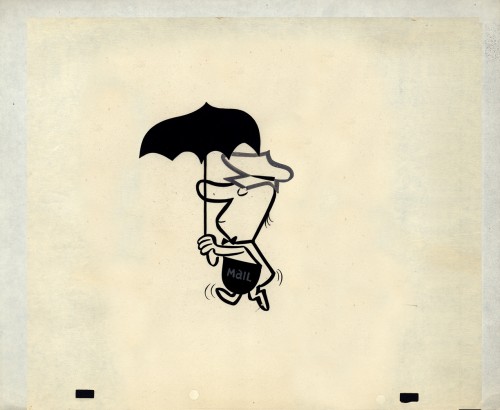 4
4
A cel not opaqued but beautifully inked.
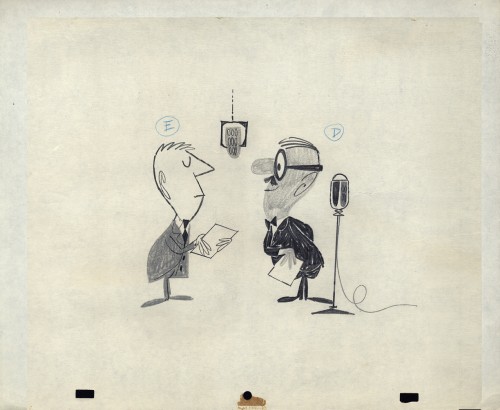 5
5
Obviously #5, 6, & 7 are the same characters in development.
It looks like #5 is probably the finished model.
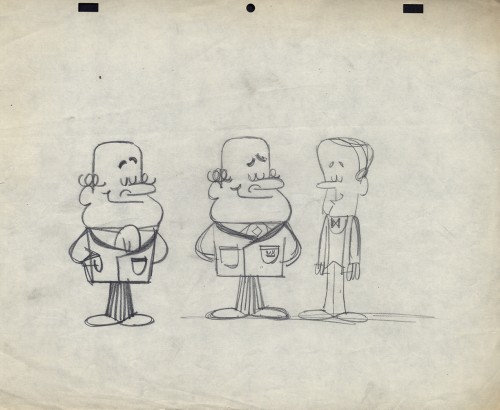 10
10
This looks a bit like Howard Beckerman’s style, but I’d
probably bet against that. The characters aren’t cute enough
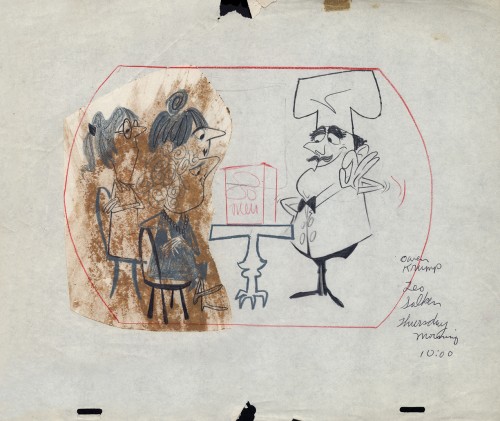 12
12
There’s a whole series of chef models
Then there’s a series of Cowboys.
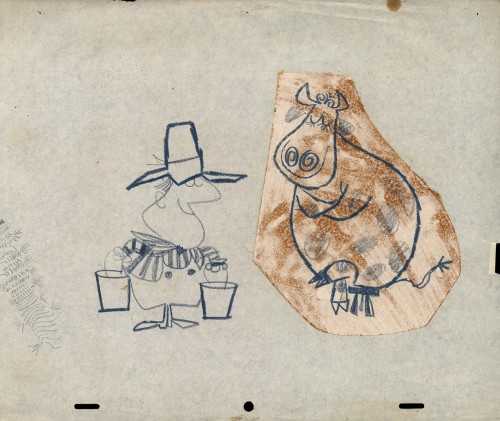 24
24
Then there’s the farmer milking the cow. Casting problems.
Illustration &Layout & Design 07 Nov 2012 06:19 am
Hal Silvermintz
- Hal Silvermintz was the Art Director and Designer for Stars & Stripes Prods. Forever Inc. as well as Designer and partner in Perpetual Motion Pictures. His design work hasn’t gotten much attention lately, so I’d like to offer a couple of pieces in the archives held by Buzzco Associates. Candy Kugel, is sending a lot of their past artwork to the Museum of Modern Art, so I’d like to showcase a few of these pieces before they’re out of my hands.
I’ll start with one of the screwiest looking storyboards I’ve ever seen. It’s for some kind of Chocolate Energy Drink. Since it’s one page and very large, I’ll present it in the one page version. Then, for you to be able to read it, I’ve broken it down into panes and will present it a second time. So here goes:
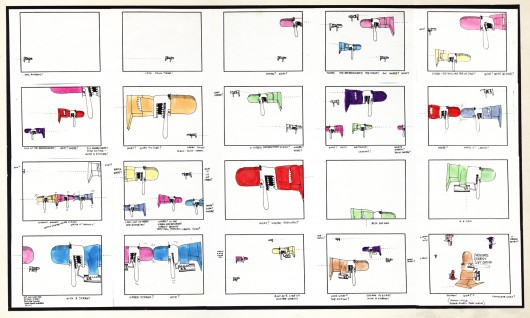
Full sized storyboard
The following are individual panels from the same board:
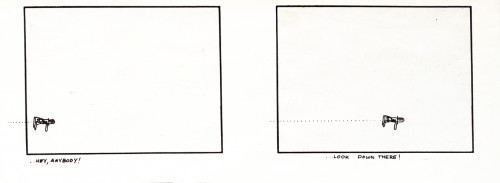 1
1(Click any image to enlarge to read.)
.
At one point Hal had designed “Fast Food Matador” for a personal film done by Hal, Candy Kugel and Vince Cafarelli. While the studio worked on the short Hal continued to turn out sketches of dancers (paint on cel) that really had nothing to do with the short, except mood.
Here are two of these.
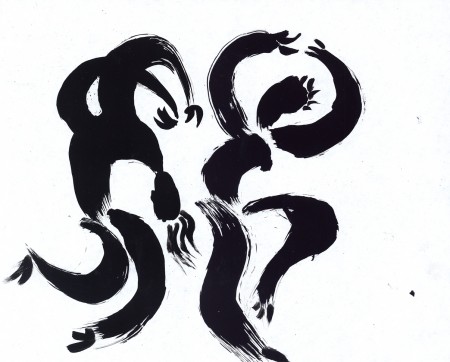 1
1
.
The following 18 pieces were done by Hal in preparation of a short the studio, Buzzco, was going to do called “Mouse Potato”. This was in 2002. The idea was it was the computer equivalent of a “couch potato.” Circumstances made them stop work on the film, but these large paintings still live on.
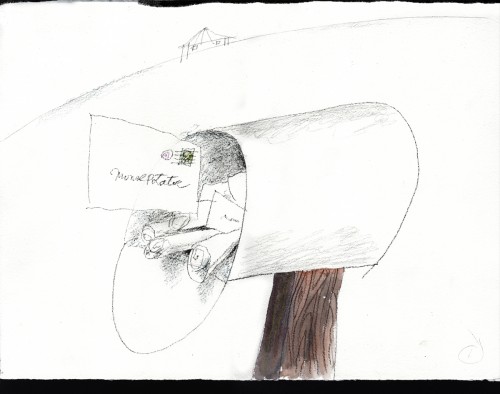 1
1
.
The following 4 pieces were done by Hal Silvermintz as personal works of art.
They weren’t done for any specific films.
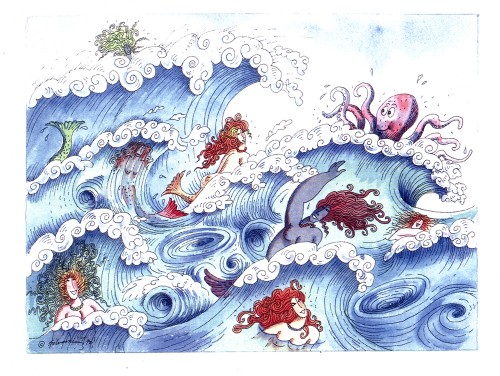 1
1
Commentary &Tissa David 05 Nov 2012 07:27 am
Speeches
At the memorial service for Tissa David five people gave speeches. I have some of those talks and am posting them here. I also have some photos that I’ll post with them. The photos are identified at the end of the post.
The entire evening was hosted, essentially, by Tissa David, herself. A 90 minute video shot at NYU has Tissa talking about her career and animation, in general. I’ve chosen a lot of clips from this video. Our entire program starts with Tissa talking to the audience about her love for animation. Short clips then precede every section of later film clips screened, and the very last word of the evening is also Tissa’s.
John Canemaker was the first speaker:
- Sunday in the Park with Tissa.
I walk across Central Park at noon to Tissa’s residence on East 83rd Street, a cozy one-bedroom apartment that always smells of baked apples and spices. It’s where she has lived since coming to New York from Paris in 1956; and that’s the year she began working as assistant to master animator Grim Natwick at UPA Studios, then located on Fifth Avenue.
It is a perfect autumn day: crisp and cool, trees in full-color spectrum, bright sunlight. The New York City marathon is in full swing. Barricades, crowds cheering the runners, detours to get you where you need to go. Friendly, happy people everywhere. New York City at its gridlocked best!
Tissa is waiting patiently outside her building, age 90 and ready to go. She wears a white peaked cap, purple/pink sweater and a stylishly long, beige raincoat over wool slacks and shiny black shoes. And she holds a rubber-tipped black cane.
She attended Catholic mass this morning, as she does every day at St. Ignasius Loyola, a church around the corner on Park Avenue run by Jesuits. As is our custom, I lean down to air-kiss one cheek, then the other, saying, “in the European manner.” She smiles and mimics me: “Yes. In the European manner.”
She takes my arm as we walk very slowly toward the Metropolitan Museum of Art two blocks west of her apartment.
She expresses interest in seeing the new Met galleries for “Art of the Arab Lands.†Both sides of her family are Armenian and the rugs of the Arabs stir her, she says.
“Have ever been to Spain?†she suddenly asks.
“Barcelona,†I answer.
“Barcelona is not Spain,†she responds. “It is — Barcelona. I mean a city like Granada, such a beautiful city. The Moorish influence in the city’s architecture and art.â€
Tissa has strong opinions about everything, especially art. I remember some years earlier running through a gallery at the Met containing one of Damien Hirst’s dead animals in formaldehyde, trying to keep up with Tissa as she hissed like a cobra: “Diss-gusting! Disssssss-gusting!â€
Her tastes are eclectic, but she maintains a special passion for Giorgio Morandi, who once said, “Nothing is more abstract than reality.†There is something in Morandi’s quiet, reclusive, deeply thoughtful, and pared-down paintings that speak to her on both personal and professional levels.
Today, however, instead of entering the museum she prefers that we walk; or, as she pronounces it in her soft Hungarian accent, “ve vauk.†Passing windows containing the Temple of Dendur, we pause. The slightly uphill route winds Tissa and she points her cane toward a cement wall. We sit watching marathon runners dash past, cheers erupting from the young crowd around us who greet the exhausted competitors, who have run for hours through all the boroughs and down Fifth Avenue and into the park for a finish near Columbus Circle.
A runner in a Superman costume hobbles by. Tissa is enjoying everything about the moment and the day, and so am I.
We talk of mutual friends. She remarks how happy she is that Michael Sporn is working on a new film. She says how much she loves Emily Hubley’s feature, The Toe Tactic.
Emily’s father, the legendary animation designer/director John Hubley, defied sexist barriers against women animators in the 1950s and 60s by hiring Tissa to animate several prestigious commercials and shorts. Tissa loved working for him, even if, she candidly notes, he was “cheap†when it came to salaries.
After ten minutes or so, we continue down the path and sit on a bench in the sun near Greywacke Arch, as runners gallop and limp across the bridge.
Inevitably, Tissa speaks of her longtime mentor Grim Natwick. And soon comes the mantra that is well-known to all her friends: “I really learned everything I know about animation from Grim.â€
She learned her lessons well. After Natwick retired, she slowly became recognized as one of the world’s great animators, and a pioneer who forged a brilliant career in a male-dominated industry. Charm, vivacity, female sensuality radiates from her superbly staging and well-timed animation, which is weaved into an admirable economical style. “You don’t do many drawings, “ she often advised novices, “but you know how to use them.â€
She thinks about animation constantly. She wonders how she would animate the Met’s splashing fountains. She ponders the numbers on digital clocks, which change shape instantaneously.
“I stare at the numbers,†she says, “and think about how I would animate the change from one to the other.â€
“It isn’t fully metamorphic,†I suggest, “but a decision about where the animator would ease into the new change.â€
Tissa thinks about that. “I would make the inbetween drawing closer to the ‘old’ number before the change,†she decides, “so there is a snap into the new number.â€
I ask Tissa if she ever wanted to marry or was in love. “Oh yes,†she answers. “I was in love many times and wanted to marry a doctor. But I was glad that he was shot by the Russians.â€
Seeing my shocked expression, she quickly adds, “I mean that it was better that I never married him because I would have quickly been miserable and it would have never worked out.â€
What about Grim?
Laughing, she says she loved him and he loved her, but it was never a romantic love. “He was my teacher. He was like my father.
“The greatest love of my life,†Tissa admits, “ was the art of animation.â€
She reflects that parts of her life have been hard. I assume she’s referring to the 1944 siege of Budapest, and her daring escape from Communist Hungary, or difficulties through the years finding her way as a female artist.
But she is thinking of more recent and personal troubles. “Between 2000 and 2010,†she explains, “I lost two brothers, two sisters, nephews and a niece. The loss of so many loved ones was almost overwhelming. I’m still angry with my younger sister Margit for dying and leaving me. She killed herself with smoking,†Tissa explains with bitter sadness.
We make our way up Fifth Avenue, then turn eastward toward her apartment.
“Thank you, John. It was really great to get out and valk.â€
I thank her for the opportunity to escape my cloistered work habits.
“You’re a long distance runner,†I say, “like the marathon racers.†She smiles and reminds me that I wrote that line in 1977 as the heading of her chapter in my first book The Animated Raggedy Ann & Andy. I don’t remind her that the full title was “Tissa David: The Loneliness of the Long-Distance Animator.â€
At her apartment house, we air-kiss “in the European manner.†My offer to help her down two steps to the front door is refused.
“I can do it,†she insists.
And she did.
This talk was followed by clips from the Hubley films:
Cockaboody
Eggs
Everybody Rides the Carousel (the Meryl Streep sequence)
Howard Beckerman followed John Canemaker
- Tissa David
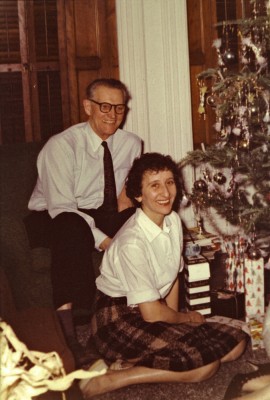 Tissa, after working at Paris based studios, entered New York animation in 1955 at UPA situated diagonally across from the Museum of Modern Art and John and Faith Hubley’s Storyboard, Inc. It was the right place for her.
Tissa, after working at Paris based studios, entered New York animation in 1955 at UPA situated diagonally across from the Museum of Modern Art and John and Faith Hubley’s Storyboard, Inc. It was the right place for her.
There had been few women animators in New York in past decades but, among the men, the held opinion was that women couldn’t do the job. There was also a general attitude that the craft was dominated by Americans. To them animation was a trade for which females and foreigners need not apply. UPA, however, was a progressive studio where the staff included various minorities and nationalities. As one talented African-American artist remarked, “When you walk in here you feel comfortable and welcomed.”
Tissa was greeted by animator Grim Natwick. His European art studies long behind him, he was the choice crew member to interview the then English challenged Tissa. Natwick was direct, ___________Tissa and Grim at Christmas
“What do you think of animation?”
Tissa hesitated , then replied, “Animation is animation.” That satisfied Natwick. Tissa was given a try out on a character from the studio’s popular Piel’s Beer commercials and then hired. The brief meeting with Grim was expressly important because the film that inspired her to get into animation was Disney’s Snow White and the Seven Dwarfs for which Natwick had animated 80% of the lead character. Tissa became Grim’s assistant beginning an association that lasted 35 years.
In time, Tissa became an animator in her own right at local studios giving life to TV commercials. Later came requests from producers with a broader range of diverse characters. These included John and Faith Hubley, R.O. Blechman and Michael Sporn all who came to depend on her animation skills and unique intellectual qualities. Tissa entered a legacy laid down by earlier European animators, illustrators and designers whose influence profoundly effected American cartoons. Working at Disney and Fleischer Studios, their affinity to old world castles, cottages and colorful personalities added credibility, charm and warmth to animated features.
Tissa also played an outstanding role in the ASIFA-East chapter. She organized and corralled the membership lists and dues collections. This was at a time when new graphics guilds were entering the field with lists of 2000 or more, but Tissa proudly managed our 250 or so enthusiatic members.
She was a prime promoter and facilitator of the ASIFA-East Film Festival, and tabulated the voting results as well as commanding the arranging of the event’s refreshment tables. Under her discriminating gaze many of us schlepped wine bottles and tubs of cheese.
I worked with Tissa at various studios around the city and remember a gratifying moment one rainy day when she and Grim came to one of my classes. They had gotten lost in SVA’s internal maze, arriving late and dripping wet. Though tardy, they added substance to the class by answering questions and giving weight to the realities of the field. To the familiar student concern about whether the character of Snow White was traced over live-action actors, Grim, chalk in hand, sketched Snow White to clearly illustrate why her cartooned proportions didn’t allow for rotoscoping.
There’s one anecdote regarding Tissa that I’ve repeated many times, but it still warms my heart, so pardon me if you’ve heard this before. I feel it’s worth repeating since it indicates Tissa’s warmth, humor and life-energizing spirit that rose above everyday twists and turns.
Tissa often traveled to Europe to see family and to animate for small studios. She also had a country house in Southern France. In the spring of 1974, while working in Holland, she contacted Iris and I about attending the animation festival in Zagreb. Her suggestion was that we meet her in Paris a week before the event. She kept a small Volks station wagon there and proposed that we drive across Europe to Zagreb. We accepted gladly. It would be a wonderful journey with a great guide. After a night in Paris we drove south through agrarian countryside evoking the colors of Van Gogh and other post impressionist painters. We stopped in a small town so Tissa could check out her French country place and then we found a small, inexpensive hotel for the night. Tissa suggested that Iris and I take a back room and she a front room. Our lodging was simple, but when we opened the shutters to let in the good night air, we saw the shining moon behind silhouetted castle towers. We slept soundly.
The next morning at breakfast we wondered if she had slept well. “Oh it was terrible!” she replied, “Big trucks rattling past my window all night!” We traveled on through southern France and into northern Italy. One late afternoon we arrived at a local hotel and prepared for a night’s rest before entering Venice. We agreed that this time Tissa would take a back room and we a front room. We slept soundly.
In the morning came our question,” How did you sleep?” It was terrible!” she replied, “There were people playing guitars and singing all night in the courtyard!”
Tissa David will be remembered as a person of taste, humor, artistic skills and a wide understanding of people and the world in general. She observed and interpreted things in a private way. She appreciated much but was opinionated and disdainful of things that didn’t meet her standards. Tissa was a dedicated animator on all manner of productions from workaday TV announcements to celebrated award winners. Though a very private person, she was a friend and mentor to many. She was a treasure in our midst. For all of us who knew and admired her, she will be missed.
Howard’s talk was followed by a clip from Raggedy Ann and Andy
her Candy Hearts and Paper Flowers sequence.
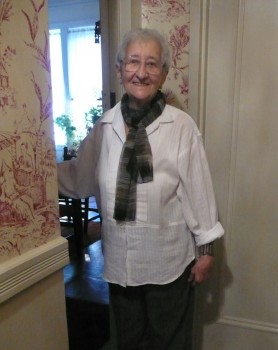 R.O. Blechman was the next speaker. His short talk was planned but spoken off the cuff, improvised. There’s no transcript of it.
R.O. Blechman was the next speaker. His short talk was planned but spoken off the cuff, improvised. There’s no transcript of it.
He started by quoting a poem Tissa liked by T.S.Elliott in which Tissa had substituted the word “animator” for “poet”. Bob also told the story of an article about his show Simple Gifts in which he called the 5 designers, “Artists.” Bob was surprised that Tissa had confronted him by telling him that she was an “Artist” yet there was no mention of her in the promotional article.
Bob’s talk was followed by clips from his studio:
3 commercials for:
– Perrier
– Banco
– WQXR radio
a clip from a promotional trailer for Candide, a film Bob sought to make as a feature.
a clip from The Soldier’s Tale, Blechman’s Emmy winning adaptation of Stravinsky’s work.
Candy Kugel was the next speaker.
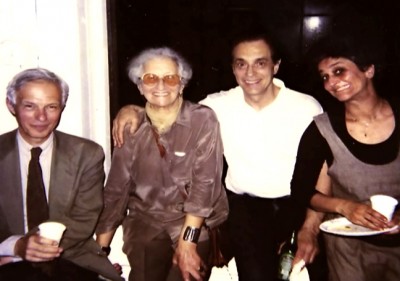 Tissa was my role model—a pathfinder. When I entered the animation industry in the 1970’s there were no other female animators beside her and I was experiencing the same sexist attitudes as she did. And I was in awe of her ability—her fluid line and acting. And finally, I was always grateful for her introduction__________(LtoR) Blechman, Tissa, Vince Cafarelli, Candy Kugel
Tissa was my role model—a pathfinder. When I entered the animation industry in the 1970’s there were no other female animators beside her and I was experiencing the same sexist attitudes as she did. And I was in awe of her ability—her fluid line and acting. And finally, I was always grateful for her introduction__________(LtoR) Blechman, Tissa, Vince Cafarelli, Candy Kugelto international animation and ASIFA.
The first time I was introduced to Tissa was on the telephone in the summer of 1972. I was about to go to Italy for my last year of art school after spending summers interning at Perpetual Motion Pictures.
My boss, the designer Hal Silvermintz, told me that Tissa knew everyone in Europe and she could give me the names of studios so that I could visit them while there. She did, and I did – in Rome, Zagreb and Budapest. And then, since Annecy would have its festival that June, she encouraged me to go and gave me the address to write for certification.
I did go to Annecy and it opened my eyes to international animation in a way I could never have imagined before. There was no internet then, no DVDs and no video collections—the only way you could see these movies was projected in a theater. And I do remember briefly meeting Grim Natwick (who drew me a Betty Boop) and Tissa.
When I returned to New York, it was a bad time for animation so I went to Los Angeles to try my luck there. In New York I had had the good fortune to be treated well by my bosses—my main responsibility was to help the designer.
I had some rudimentary animation experience, but the real animation was done by experienced animators, and they came from a culture of secrecy.
In LA I went to Disney with my “reel†and portfolio and found a whole other set of obstacles. The front gate passes had “Mr.†printed on the guest line. This was during the feminist movement and I jokingly said to the woman behind the window—“I guess you don’t see very many women hereâ€â€”she scratched off the Mr and roughly handed it back to me. I met with 3 men, including Don Duckwall. They told me I drew nicely but that women just don’t have what it takes to be an animator. Women lack timing. Maybe I should consider becoming a designer or background artist.
“But I want my drawings to ACT!†I protested. They smiled and shook their heads.
In the end, I returned to work fulltime at Perpetual. I was determined to learn how to animate well. I got to know Tissa through ASIFA and she offered to help me.
Perpetual picked up a project that had an incredibly low budget, so they gave it to me. Whatever I could manage would be enough. Vincent Cafarelli had recently started freelancing there, and although he was open to helping me, he encouraged me to seek out Tissa’s advice. They had worked together at UPA and he had great respect for her. He even told me I flipped like her.
Tissa invited me to her home and she demonstrated some things. And gave me homework. I went a few more times—I wish I could say that I was a stellar student, but I’m afraid her criticism, although completely deserved, was too biting for my fragile ego.
She was my idol—I loved her work – her beautiful line and her acting. I respected her immensely—but I think I must have been a great disappointment to her. At that time, I was the only girl working her way to become an animator in an established animation studio in NY. I imagine she was hoping for a protégé equal to her talents.
But even without the lessons we remained friends. She followed my career closely and we worked together in ASIFA.
We both understood the difficulty in working in a “man’s profession.†I was criticized by the ink and paint department for not being one of the girls—I was a guy because I used a pencil and not a brush. Outside of Perpetual there were animators and assistants who thought it wrong of me to take a man’s job. Some kiddingly said they would “break my fingers.â€
I admired Tissa even more, knowing exactly what she had been through.
But we never spoke about it after our first meeting at her apartment: I gingerly asked her about how she dealt with the male animators—their practical jokes, the macho culture–were there rumors about her and Grim? She looked at me harshly and waved her hand. Who needed to complain—it was just part of the job.
I will miss Tissa—her generous spirit, her biting wit and her talent. There are too few of them out there.
Candy’s talk was followed by clips from 3 films done for Michael Sporn Animation:
Lyle Lyle Crocodile
The Red Shoes
The Story of the Dancing Frog
Arlane Nelson was the next speaker.
- As Michael said, I am one of Tissa’s nieces. An interesting side note, Tissa was one of 10 children, 7 girls, 3 boys. In my generation, the next one, there were only a total of 3 girls among all the nieces and nephews.
I’d like to begin with an email one of my Hungarian cousins sent me:
“Tissa was known to love music, and we had talked a lot about our favorite performers: Horowitz, Goild, and many other artists. However one thing that is not common in elderly people, is to be open to new things, as Tissa had been. Once I saw a movie about the life of Manuel de Falla, which has a lot of music inserted, one even recorded during his short life. The recording is very interesting because when Falla wrote his masterpiece, El Amor Brujo, he wanted to reject it because the passion radiating from the piece is in total contrast with his deep catholic faith.
Manuel de Falla, just as Kodaly did, collected folk music, the music of the flamenco playing gypsies. El Amor Brujo totally gives back this surreal feeling. In the movie, in order for the illustration to be perfect, two songs, that are accompanied by a large orchestra, were sung by a young female gypsy singer with the technique typical to flamenco. The passion radiating from the recording is scary. I showed it to Tissa who said that this woman is like a storm. And she started telling me stories about being in Andalusia, listening to flamenco music, and how much she liked it.
The other memory is connected to flamenco as well. Many people think that they like this musical style, while they only meet the civilised versions. I have watched Saura’s movie, called Flamenco in which there is a part when two old gypsy men sit on a chair and sing without music. One of them has golden teeth, the other one has silver teeth. This is of course not singing according to European standards, this is rather some endless, sharp, painful, and aggressive shouting, confined among borders. As far as my experience goes, only a few can understand this deepness of art. Tissa understood it, we talked a lot about it later on, and she pointed out the complicated symbols in the text that I had missed on my own.â€
Anyway, I live in the Washington metropolitan area and as such, we used to see Tissa a lot; more than any of our other relatives. She’d be down to visit us several times a year and sometimes, we came up to visit her. I’d like to share a few of my memories of who Tissa was.
Growing up, we kind of knew that Tissa was a famous person and we were very proud of this. I can remember, when my sister and I were small and Tissa came to visit, we had to wait until the morning, but we would go charging in and have her tell us the latest Letterman shorts she had done. So we’d know the stories before anyone else did.
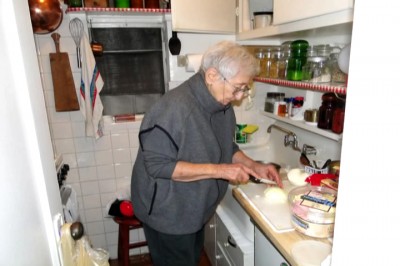 Tissa loved cooking. Whenever she came to visit, she took over the kitchen; you entered at your own risk. Except for the dogs, who usually waited in endless vigil watching every step, every action with rapt attention for the treasures they knew would fall. One of the things I found__________Tissa cooking in her NY kitchen
Tissa loved cooking. Whenever she came to visit, she took over the kitchen; you entered at your own risk. Except for the dogs, who usually waited in endless vigil watching every step, every action with rapt attention for the treasures they knew would fall. One of the things I found__________Tissa cooking in her NY kitchen
inexplicable was her use of
cooking implements which would increase exponentially with availability. A dish she would make in her tiny kitchen might take 2 bowls and a pot. The same dish in our house, could take 7 bowls, 5 pots, and 3 pans. Any time you walked in to the kitchen, all burners would be going, some would even have two things on at the same time. A couple of things would be waiting on the side for a burner to free up, some other dishes would be done, there would be something at the chopping board in mid process, and usually a vegetable of some kind hanging out in a colander in the sink. Or trying to get a recipe from her was always a challenge. For example, when she was trying to explain how to make galuska to us: You started with a cup of flour and one egg. Then you added milk. Okay. So, how much? Well, as much as it takes so that if you stick a spoon straight up into the batter, it would fall over very slowly. There was another time I wanted to make Beigli for Christmas. Tissa said she would send me my aunt Dusi’s recipe because it was the best. Again, you started with 70 decagrams of flour, grated in some lemon rind and then sour cream. How much? Well, this time you had to add just enough so that the dough would behave when pinched like an old woman’s skin. Needless to say, without centuries of Hungarian cooking practices ingrained, whenever I did anything with Tissa, I ended up taking a novel’s worth of notes.
I remember once having a conversation with Tissa in which she quite definitively stated that it was a shame Scotsmen wore kilts as they had some of the ugliest knees in the world. I want to say that she thought the Germans or Dutch would have been better suited. Despite his having ugly knees, tho, Tissa admitted to a fondness for Sean Connery.
Tissa was also a very generous person. We were always welcome at her place as long as you did not mind the conditions. Anyone who was ever at her apartment knows it was rather small. But we would make it work. I remember one time when I was 8 or 9, there must have been 7 of us there. I can still see myself picking my way carefully across the floor of sleeping bodies to get to the bathroom. My children especially looked forward to our New York trips: the rules of living conditions were suspended and there were so many things to engage little minds. Then when my mother was sick, Tissa packed up and moved in for as long as it was going to take helping to take care of my mother so that she could have her wish of dying at home. It was this same wish of Tissa’s, I’m glad I had some part in returning.
Another thing that was important to Tissa was her faith. She always had this quiet, laid back, do what you are going do attitude. I always thought it was part of the reason she seemed so at peace with things, even her death. No matter what else happened or changed, Tissa had this. She was very different than my mother in this way. Tissa didn’t fly off the handle, or ram things down your throat, or sweat the small stuff. She knew what was important to her and the rest didn’t bother her. Tissa also was very adamant that my sister’s memorial marker have a cross. Despite my sister’s claims to atheism, Tissa was convinced that Tamar found redemption in the end.
Before I had children, I used to go to the movies every weekend, so, Tissa and I would compare notes on films we had seen. Very often, they would be showing in New York weeks before the artsy theaters in DC picked them up, so Tissa would let me know what to add to my list. However, we often found we had different sensibilities. One such film was The Triplets of Belleville. Tissa told me I had to see it: it was wonderful not only as an animated film but also for the story of the boy and his grandmother. After I saw it, I called Tissa and told her that yes, it had been a wonderful film, but she should have warned me about the frogs. Tissa paused a moment and then said “Oh, yes, the frogs. That was a very funny scene.†I responded “No, it wasn’t funny, it was tragic and you should have prepared me.â€
Tissa did not like technology, but accepted it as a necessary evil. However, she refused to take the time to understand how things worked. Many times when I came up to see her, Tissa would have some contraption that she needed me to install or set up: an answering machine, a VCR, an antenna, the HD receiver, a hand held sudoku game, etcetera. Once I was done tho, she didn’t want to know the details, just the buttons she needed to press. We tried for years to get her onto email, but she wouldn’t hear of it. There would be no computers, no cell phones, no tablets, nothing of that kind ever with Tissa.
The last time I brought my children up to see Tissa – at the end of July – you could see how happy it made her to sit and watch them play. She always enjoyed the children in her life, even after we thought we had grown up. She was kind and nurturing and a mother to us all. Whether she was teaching us, encouraging us, forming us, feeding us our favorite creamed spinach, or just loving us. She was an important fixture in all our lives and one we will make sure no one ever forgets.
Arlane’s talk was followed by a long clip from a film Tissa animated for me,
The Marzipan Pig.
My speech followed. It was the last of the evening. I gave it extemporaneously, and there is no transcript of it. I tried to be as funny as I could, and that worked. The following is the original speech I walked in with. It’s not good, bathetic and inapropriate for the final talk. My changes worked. To give an indication of the final, though, I’ve decided to leave this here.
Michael Sporn
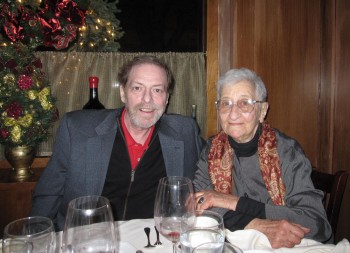 Forty years ago, on Tuesday Oct 10, 1972, 1 had just started my second day in animation working for John and Faith Hubley. I was scheduled to work three days to help finish a commercial. Helen Komar was the only other person working on that commercial with me. She was the production coordinator. My second day there, and I was working as intensely as 1 could. 1 loved being there, I was finally doing animation and getting paid for it.
Forty years ago, on Tuesday Oct 10, 1972, 1 had just started my second day in animation working for John and Faith Hubley. I was scheduled to work three days to help finish a commercial. Helen Komar was the only other person working on that commercial with me. She was the production coordinator. My second day there, and I was working as intensely as 1 could. 1 loved being there, I was finally doing animation and getting paid for it.
That day, 1 continued to work through my lunch break; I wanted to get it right. That’s when T heard this voice with a sharp Hungarian accent say loud enough, “Who has been doing such HORRIBLE inbetweens?” Sheepishly I looked up and had to admit that we all knew she was talking about me. Especially since I was the only one doing inbetweens. That’s how I met Tissa David.
Tissa proposed I come to take lessons from her; she would help teach me what she could about animation. This meant I spent a lot of time doing homework that Tissa would give me inbetweening over and over and over again animation drawings that were usually from a scene that Grim Natwick had animated. Back then, Tissa had a sharp way of telling you how bad you were. It didn’t take me long to find the humor in what she had to say, especially since 1 was even more of a critic of my own work than she was.
Things changed a bit over the years. Tissa grew more and more reserved with her opinions. She made an obvious attempt to moderate herself when she thought it was too harsh. However, I always tried to encourage her to fully express what she thought about my work, and I like to think she was honest with me throughout.
Somewhere along the line I stopped asking for help with animation. Slowly we became more friends rather than teacher and student. When she left the Hubley studio to work for Richard Williams on Raggedy Ann, knowing full well that I was a big fan
of Dick Williams’ work, she maneuvered a job for me on the production. Starting as an inbetweener, I worked my way up to the position of head of Assistants and Inbetweeners.
After that, I was hired by Bob Blechman to be his Asst Director working on a Christmas Special. Before we got to that we did a number of commercials together. Once Bob had difficulty finding an animator, and 11 talked loudly and enthusiastically about Tissa’s work. She soon started working with Bob in a relationship that lasted years.
When I formed my own studio, I directed a number of half hour shows. Tissa was happy to work for me in many capacities. She did storyboard, layout and sometimes animation. We helped each other often by just being there. That made a lot of the jobs more fun, and helped me feel even more proud of the work I was doing.
The last couple of years weren’t about animation, really. Yet the two of us were able to keep laughing throughout. And talking. Talking about museum shows and films that we saw. Sharing books we’d read or just sometimes talking. I was never much of a phone person so it had to be face on.
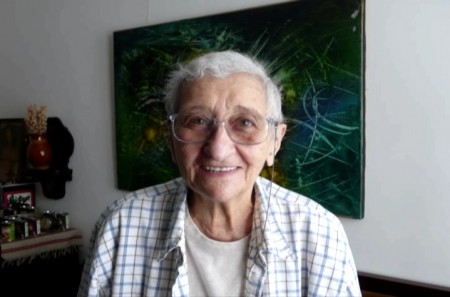
Tissa in her Living Room
Photo by Mate Hidvegi
In the end 1 learned that Tissa had developed a brain tumor. Of course, I didn’t know whether that meant she would have a long slow death or a quick one. 1 went one Saturday afternoon and laughed quite a bit with Tissa. When I brought up old names and places and events, she remembered them clearly. If she tried to remember something, she couldn’t, and the conversations would end flat. It meant I had to keep talking.
I left that afternoon and expected to return five days later. But that day I got a call from Susan Davis telling me that Tissa had died that day. She didn’t feel well in the morning, lay down for a while, and didn’t wake up.
I think her passing won’t really hit me for a while. I’ve been spending a lot of time editing this footage. Now this memorial is done, and I think the reality won’t hit home until Christmas. Every year, I’ve received a wonderful fruit cake from Tissa. In fact, I still have a couple unopened. I know that one won’t arrive this year, and I’ll miss my fruitcake this year.
This talk was followed by the last animation work Tissa did,
part of the animatic for my feature, POE.
.
.
 1
1
a 1942 drawing by Tissa’s close friend, artist,
Judit Reigl. The drawing is in the collection
of Tissa’s sister, Katalin David.
Thanks to Mate Hidvegi, Katalin’s son, for sending it.
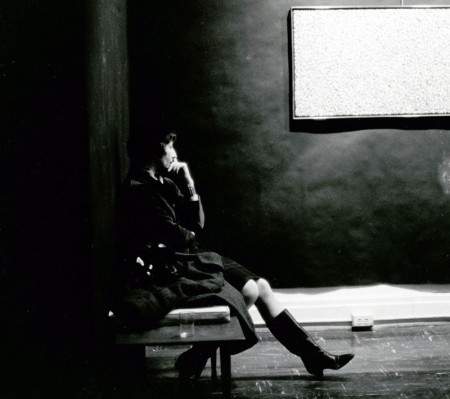 2
2
Tissa in an Art Gallery in the 60s
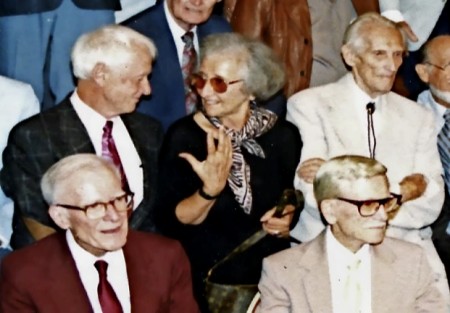 3
3
At Grim Natwick’s 100th birthday
(L to R) Duane Crowther, Tissa, Grim Natwick
in front of them: Frank Thomas, Virgil Ross
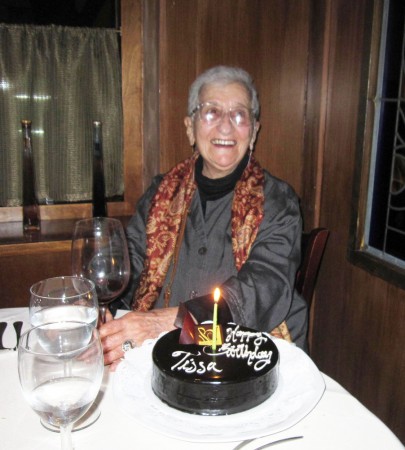 4
4
Tissa on her 90th birthday celebration dinner
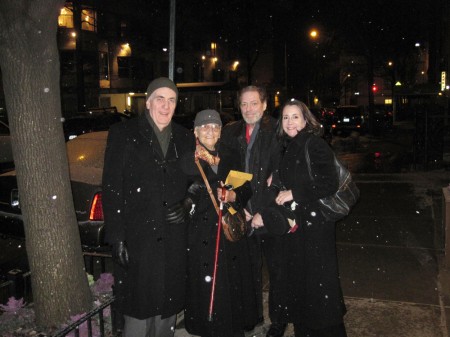 6
6
(L to R) John Canemaker, Tissa, Me, Heidi Stallings
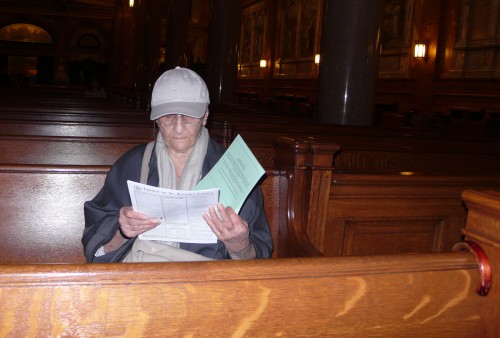 7
7
Tissa in St. Ignatius Loyola Church, 84th St, Madison Ave.
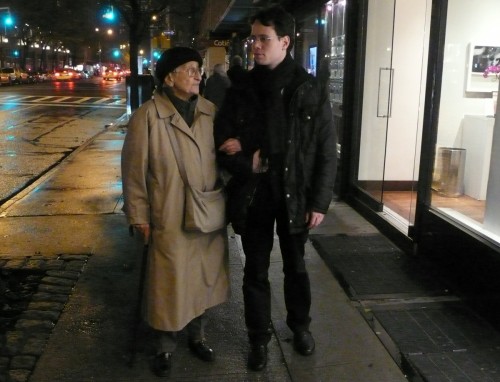 8
8
Tissa with Aron Hidvegi, her grand nephew
4, 5, & 6 photographed by Joe Kennedy
7, 8, 9, 11 & 12 photographed by Mate Hidvegi
10 photographed by Aron Hidvegi
Animation Artifacts &commercial animation &Layout & Design &Models 31 Oct 2012 09:27 am
Vince Cafarelli’s Millbrook Bread – 3
- As I’ve shown in a couple of past posts, Millbrook Bread was a profitable series for the young animation studio, Goulding-Elliott-Graham. See posts 1 and 2.
Vince Cafarelli collected a lot of drawings from various commercials that he worked on over the years, and there’s an abundance of art from this small studio. All of it good to great. Unfortunately, very little of this art is well labelled, and a lot of the ordering of the artwork is pure conjecture to get it to fall into place. I’ve grown quite attached to some of the material from this series and its characters. The design, to me, is just very attractive. Consequently I can’t hesitate to add more to view. Here’s models and art from two more spots.
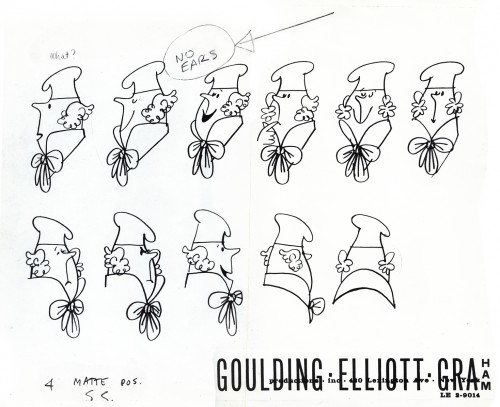
“Minny” the Baker Model 1
Animation Artifacts &Art Art &commercial animation &Layout & Design &Models 17 Oct 2012 06:21 am
Mogubgub 2
- Fred Mogubgub was a rare bird in animation. He was truly out there. Maybe today we’d say he was ahead of his time.
He was a close friend of Vincent Cafarelli’s and did some creative work with their studio. He also left a residue of artwork behind him. I located a folder of layouts and such artwork.
There’s also the program for his Memorial service. I’ve decided to include that here in this post.
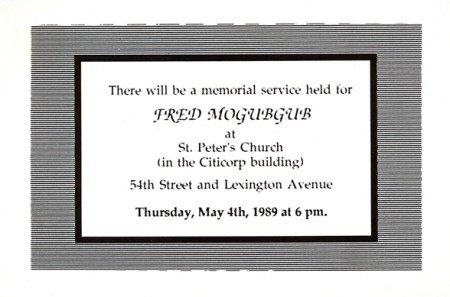
Invitation to the Memorial Service.
Here are a series of drawings Fred did for a Yakov Smirnoff “Funfacts” piece for ABC tv. These were 20 second spots for the network.
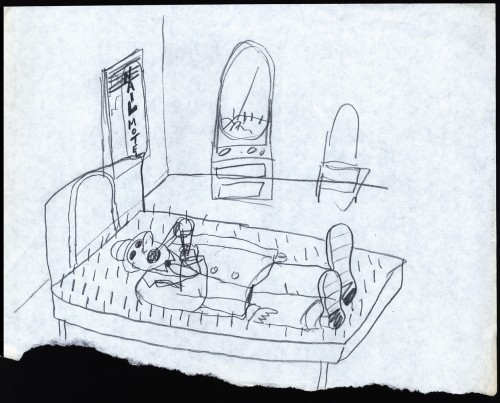 1
1
Here are some randy gags Fred drew – studio gags.
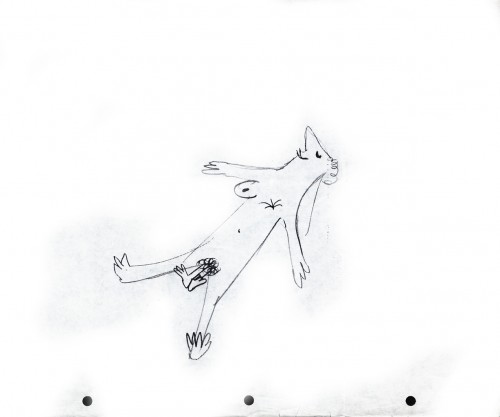 1
1
Fred had to balance the commercialism with the art.
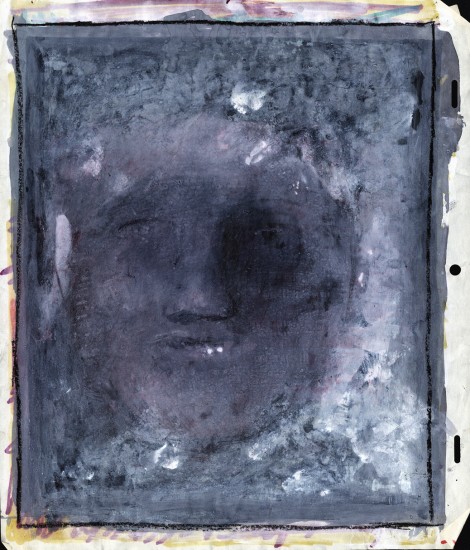
Commentary &commercial animation &Photos 13 Oct 2012 04:53 am
Stuff Happens
 - Tuesday brought an Academy event. Howard W. Koch Jr., known widely as “Hawk,” succeeded Tom Sherak as president of the Academy last August. He came to New York to meet the East Coast members, here, and to congratulate this year’s crop of new members. (Emily Hubley is one of the brand new members in New York.)
- Tuesday brought an Academy event. Howard W. Koch Jr., known widely as “Hawk,” succeeded Tom Sherak as president of the Academy last August. He came to New York to meet the East Coast members, here, and to congratulate this year’s crop of new members. (Emily Hubley is one of the brand new members in New York.)
There was an excellent reception at the Stone Rose Lounge, a relatively new eatery in the Columbus Circle area. The event was pleasant with a notable number of celebrities milling about: Daniel Craig, Rachel Weisz, Billy Dee Williams, S. Epatha Merkerson, Richard Gere and Michael Douglas. There was plenty of drink (martinis seemed to be the drink of choice) and some great hors d’oeurves. The lobster tacos (about 1/2 inch long) and the meatball sliders were both delicious.
The speeches were kept to a minimum. Howard Koch was the only speaker and he spoke for maybe five minutes. The rest was the members chatting each other up. Heidi and I got to talk with Mr. Koch in a relaxed situation for about 15 minutes. We spent plenty of time with John Canemaker & Joe Kennedy, Emily Hubley & Will Rosenthal, Biljana Labovic, and Candy Kugel with her sister, Tina Hirsch. As I said, it was a pleasant evening.
- Thursday evening I saw a screening of Burton’s Frankenweenie. See my review, below.
- On Friday ASIFA East and The School of Visual Arts Animation Department had a regrouping of the original commercial animation studio, Perpetual Motion Studios. I wrote about this in depth with some pictures from the event, at the end of this post. Scroll down.
While I was watching this event, the Yankees won the division series over the Baltimore Orioles. Buck Showalter and his Orioles put up an amazing fight. I’m exhausted having gone through the competition with this team that came out of nowhere. Onto Detroit, next.
the Brew Makes Some Changes
I didn’t get the note from anyone that Cartoon Brew was changing their look. It was a surprise one day to go to the site and find something that looked wildly commercial, all headlines and no stories. Oh, wait. The stories are there, you just have to keep clicking on things. It looks incredibly commercial and blaring so early in the morning. I guess it’s good for them. It was a surprise to me, and it feels a bit overwhelming. I’m not sure I like going to the site of loud headlines. Though they do have all the information in cartoon town. What’re you going to do? You have to go with the flow, even when you’re heading downstream or so it often feels. Congratulations Cartoon Brew.
Katsuhiro Otomo at Platform Festival
- I received this in my email folder:
- I’m excited to share some big news with you. Anime legend Katsuhiro Otomo is slated to appear at the PLATFORM INT’L ANIMATION FESTIVAL at the end of this month, where they will be screening his new short film, COMBUSTIBLE, and also honoring him with a Lifetime Achievement Award. See attached for a full press release.
It would be great if you could cover this great event and also run the announcement ASAP. I’m including an image as well, and can provide a couple more if you’re interested. As space is limited at this event, please let me know if you are interested in a press pass to the event, and also if you’d like to interview Otomo 1:1 while he is here.
How could I not partake of such an interview. I immediately wrote back to say, yes., I wanted IN.
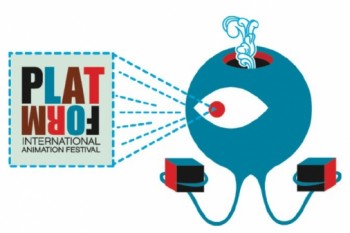 But first, I had to find out who Katsuhiro Otomo is. I looked him up on Google and found out he had directed Akira.
But first, I had to find out who Katsuhiro Otomo is. I looked him up on Google and found out he had directed Akira.
Now, Akira is one of those films that I’ve never been able to sit through. Lots of overworked, integrated animation takes place in a very convoluted story that is virtually impossible to follow. I didn’t make it past five minutes on the first attempt. Fifteen minutes on the next half dozen times. The film is magnificently rendered large, but totally impossible to sit through.
Look at that still, at the top of this post. Crowds of people running and milling about. No focus; no individuals. This is the chosen still to send out accompanying the film. A crowd shot. Busywork. No focus on characters, no identification with any personality. A crowd. That, to me, is Akira.
Sure, I’d like to meet the guy who made this film. It’s such busywork, that it defies itself and its own creation.
However, the Platform Animation Festival will take place in Los Angeles on Friday, October 26, 2012 to Sunday, October 28, 2012. Jerry Beck will interview Mr. Otomo on Sat, Oct. 27th at 9:30 PM. It might be worth attending. Jerry knows what he’s talking about when it comes to Manga, and Mr. Otomo will be making a rare visit to LA.
On Thursday evening, I saw Tim Burton‘s most recent puppet animated feature, Frankenweenie. This, as many of you already know, is a reworking of the live-action short Burton did in 1984. In many ways it doesn’t improve on that short. It basically tells the same story with an added number of homage sequences devoted to various horror flicks that Burton obviously loved.
The film is sweet with no strong conflicts to trouble little children. The animation feels ever-so-slightly limited, but I liked it. It often felt like there was a smile behind the movement, and that the animators were having fun on this film. Quite a few eccentric moves helped to make the gestures feel more individual. Unlike Para Norman, the film isn’t overly slick. That Leica film felt as though it might have been cg animated. You couldn’t really feel the fingerprints on the action. I do like that aspect of Frankenweenie. I always was sure it was real objects being animated, not some cgi puppet.
However, there was often a stiffness to the motion. In some of the first scenes, the lead boy walks as if his legs had no knees.
This might have been less noticeable if I had been more involved in a deeper story, but that is a big problem with the film. The story isn’t particularly engaging. It’s just sweet.
Of Burton’s three animated features this was the least of them.
It’s Such a Beautiful Day
It’s Such a Beautiful Day is the title of the feature which Don Hertzfeldt compiled of three shorts he produced: Everything Will Be OK (2006), I Am So Proud of You (2008) and It’s Such a Beautiful Day (2012). These shorts formed a trilogy which Hertzfeldt designed to create this feature.
It opened at the IFC theater in New York and received modest reviews from the NY press.
- Neil Genzlinger of the NYTimes wrote on Oct 4th: “Considering that he’s a stick figure, Bill, the main character in “It’s Such a Beautiful Day,†sure does have a complex internal life. And this animated film by Don Hertzfeldt does an amazing job of making you feel it, in all its sadness, terror and transcendence.”
The film will continue to tour around the country playing at many cities from Columbia, Mo to Tucson, Az to Chicago, Il. The planned schedule for the tour cn be found here (scroll down).
There’s an excellent interview with Hertzfeldt in The Onion‘s AV Club section which was printed last April when Hertzfeldt initially toured with the film.
Perpetual
- Yesterday, ASIFA East and The School of Visual Arts Animation Department had a regrouping of the original commercial animation studio, Perpetual Motion Studios.

Candy Kugel spearheaded this event working with support from JJ Sedelmaier, who started in Perpetual. Quite a few past employees of the studio came back for the celebration and made for an interesting evening. For them, it was no doubt a reu-nion, for the rest of us it was a visit to a key commercial studio in New York.
The event was prompted by the recent deaths of three of the key personnel. Vincent Cafarelli, Buzz Potamkin and Hal Silvermintz all died within six months of each other, this past year. Rather than making it a memorial for the three, they made it a celebration of the studio’s work.
Tom Warburton acted as the host for the evening. He originally was an intern starting out in Buzzco Associates, the studio that followed Perpetual. Mordicai Gerstein, Russell Calabrese, JJ Sedelmaier, and Thomas Schlamme all came in for the event and sat on a panel up on stage in front of the screen.
This panel talked about the work done at the studio and the different roles they all played,from designing to animation to making music and sound effects.
In the audience there was quite a fill of other artists and past employees from the studio. Rose Eng and Marilyn Carrington were key people in I&Pt. Background Artists Linda Daurio and Cotty Kilbanks, Animators Doug Compton and Doug Crane, Layout Artist Wayne Becker, Editor Jon Levy, Producers David Sameth and Marilyn Kraemer all reunited.
I came from a different crowd of that same period. Mine was less commercial and more theatrical a group so I didn’t know many of these people. Yet, I knew of many of them and was glad to finally meet some. I was pleased finally to meet Mordi Gerstein, having animated his children’s book The Man Who Walked Between the Towers.
I’ve seen Wayne Becker‘s drawings for years, so it was a pleasure to finally meet up with him. I’d worked frequently in my own studio with the brilliant Doug Compton, so I was glad to see him, and I knew Doug Crane from Raggedy Ann.
It’s amazing the number of people who started out at Perpetual and went on to become important directors, designers, and creators within the industry. They must have been doing something right.
As one who sat in the wings watching the planning for this event, I got to see how enormous the amount of work and the number of phone calls it took for Candy to get the event together, and Rick Broas did a lion’s share of the technical work in planning the video and graphics for the program. They did everything from a film retrospective, to announcement invitations to name labels. They’re both to be congratulated for pulling off a fantastic night’s entertainment.
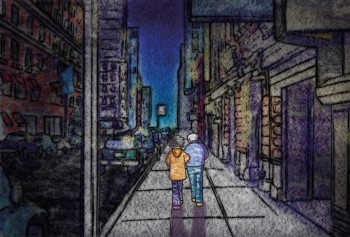 The program ended with Candy’s latest film, The Last Time, which is a memorial to her close friend and working partner since 1973, Vince Cafarelli. Although it wasn’t a Perpetual product, it celebrated the end result of that studio as Perpetual merged into Buzzco with Buzz Potamkin, Candy and Vinnie continued on after Hal Silvermintz moved to open his own studio. After Buzz moved on Candy and Vinnie continued on with the studio which remains open and busy to this day. The film is sad, but it proved to be a positive ending to the evening. look for the spanking new short on the festival circuit.Go to its Facebook page to see a clip. Candy & Rick are appropriately proud of the short.
The program ended with Candy’s latest film, The Last Time, which is a memorial to her close friend and working partner since 1973, Vince Cafarelli. Although it wasn’t a Perpetual product, it celebrated the end result of that studio as Perpetual merged into Buzzco with Buzz Potamkin, Candy and Vinnie continued on after Hal Silvermintz moved to open his own studio. After Buzz moved on Candy and Vinnie continued on with the studio which remains open and busy to this day. The film is sad, but it proved to be a positive ending to the evening. look for the spanking new short on the festival circuit.Go to its Facebook page to see a clip. Candy & Rick are appropriately proud of the short.
Here are some stills I took last night:
 1
1The theater where the show took place.
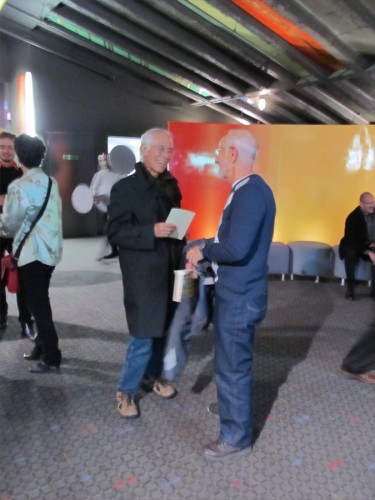
Mordicai Gerstein and Wayne Becker chat in the lobby.
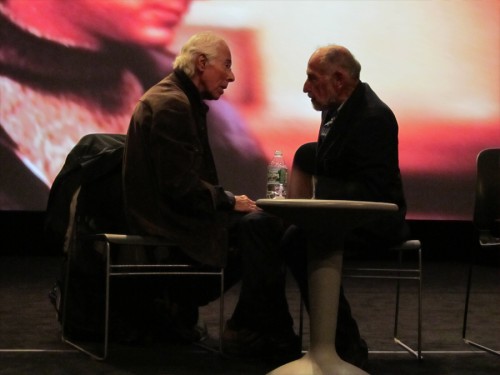 3
3
Mordicai Gerstein and Don Duga say hi on stage before the show.
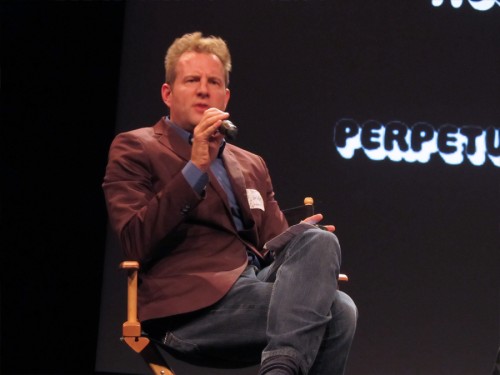 4
4
Tom Warburton moderated the panel on stage.
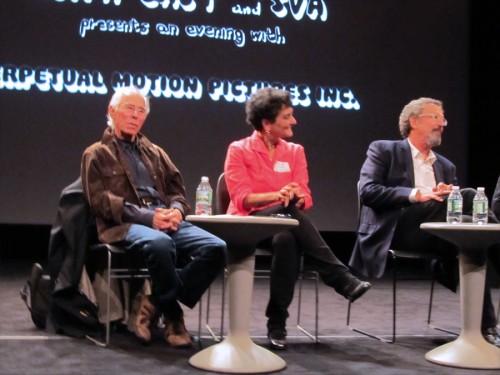 5
5
(LtoR) Mordi Gerstein, Candy Kugel, Thomas Schlamme
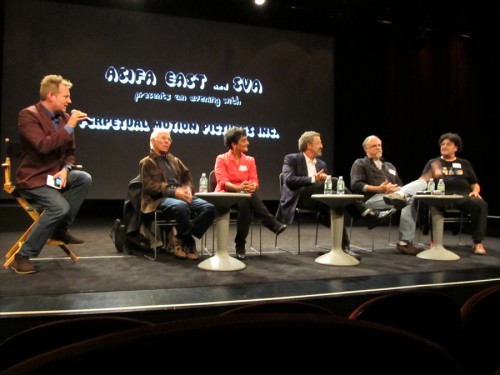 6
6
(LtoR) Tom Warburton, Mordi Gerstein, Candy Kugel,
Thomas Schlamme, JJ Sedelmaier, and Russell Calabrese
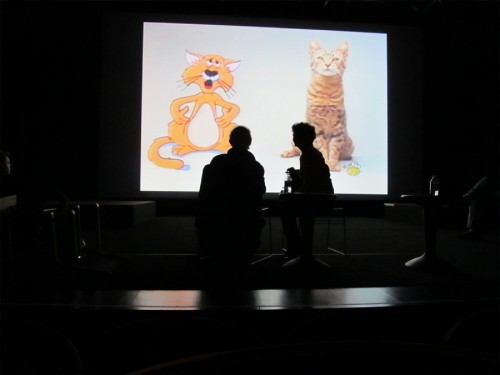 7
7
Mordi Gerstein and Candy Kugel remain on stage during the
opening filmmontage constructed by Richard O’Connor for the show.
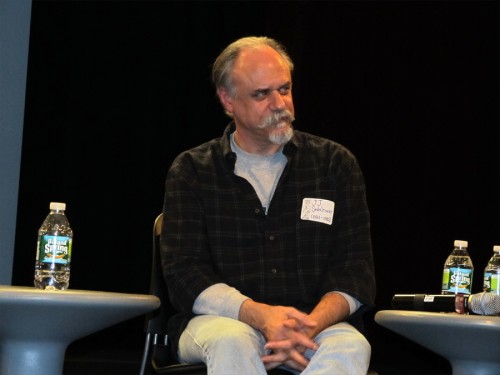 9
9
JJ Sedelmaier listens to the conversation.
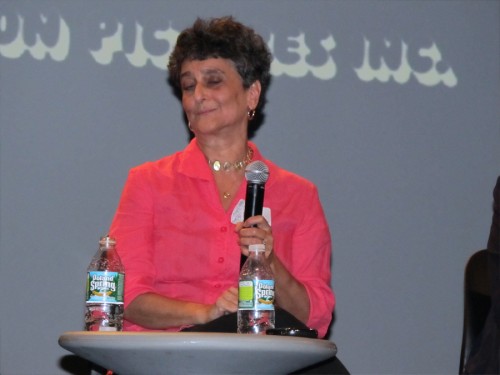 10
10
Sorry Candy. It’s a good closeup even though
my cursed camera caught you with eyes closed.
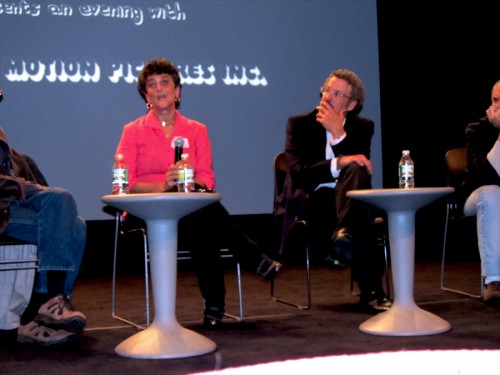 11
11
Candy and Thomas Schlamme remember.
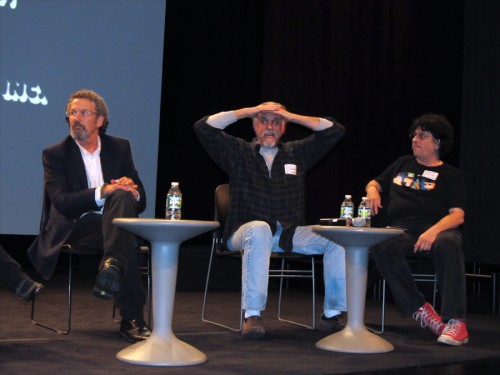 12
12
Tommie Schlamme, JJ looking out and Russell Calabrese.
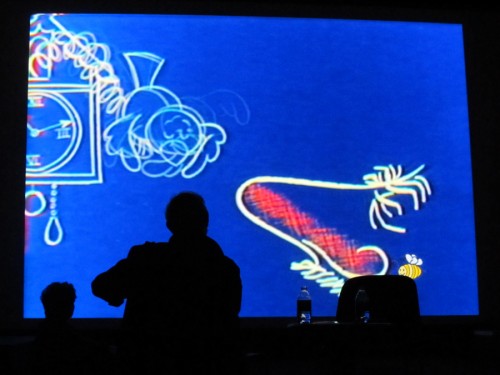 13
13
Mordi Gerstein watches some commercials
which he designed many years ago.
Animation &Animation Artifacts &Fleischer &Layout & Design &Models 10 Oct 2012 05:54 am
More Fleischer Models & Things
- Continuing on with the Vincent Cafarelli collection of artwork, I ran across some more Fleischer/Paramount models. One piece among them, I think, is something of a rarity. Here they are:
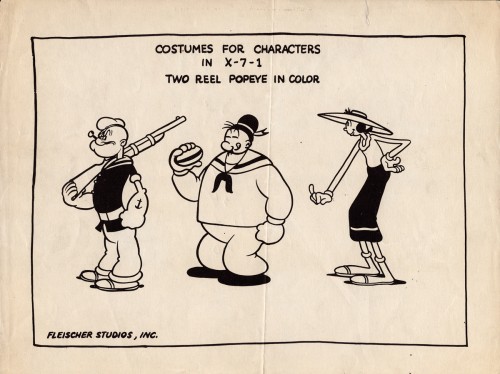 1
1
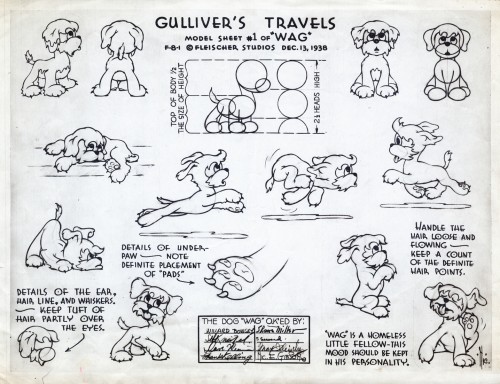 10
10
This seems to be a rarely seen model. “Wags” the dog from Gulliver’s Travels.
I think this was cut from the film, at least I’ve never noticed him.
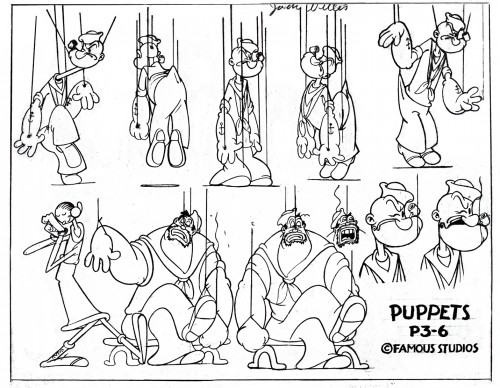 11
11
This, of course, is not Fleischer but a later Famous short.
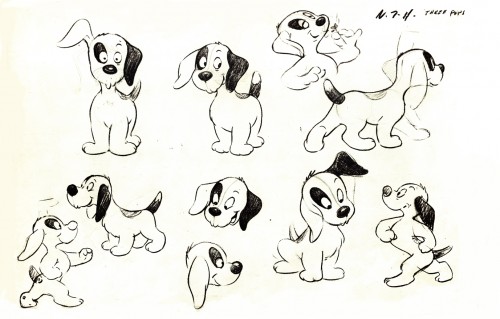 12
12
This appears to be from a later Paramount cartoon.
(Thad Komorowski identifies this as Bill Tytla’s
HECTOR’S HECTIC LIFE in the comment section of this post.)
________________________
- Here is something even rarer than that Gulliver “Wags” model sheet.
Apparently, new hirees at Famous Studios (at least in 1956) would go to an art school, of sorts. The following drawings are on reduced animation paper (although they’re the actual pencil drawings, not copies) and stapled – with two staples, one on either side – to black illustration board. Each has additional registration marks drawn at the bottom. Each is one of two drawings that are slightly different from one another. Presumably, they were designed to teach inbetweening. The pencil drawing line work is particularly thin, so I suspect these were projected with an overhead projector. I’d guess that the art student, new employee, would copy the projected drawings and then have to inbetween the pair of drawings.
The drawings start with simple lines and get progressively more difficult until it’s a full sized image of Popeye ready to throw a punch. For the sake of space, and since the first drawings aren’t very interesting, I’ve enlarged only the last half of them. The thumbnails for the first group are small, so you can see them and enlarge them, if you like. If you’re new to the field, try copying and inbetweening at least the last five pairs. It’s amazing that Vincent Cafarelli saved these, and fortuitous for us to be able to see them. Have a look:
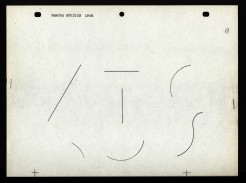 A
A 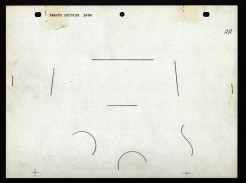 AA
AA
Commentary 06 Oct 2012 07:29 am
Effectively Functioning
Predominantly, I’ve been completely absorbed by two things. Tissa David‘s memorial is just about organized. The rough cut of the film program has been assembled, and I’ll hand it off to my favorite editor, Paul Carrillo, who will add some rhythm and grace. Tissa deserves that much from me.
I need to thank Candy Kugel for offering her facility to put this together. It was a lot of work. Thanks also to Rick Broas for doing so much of the technical work that I have no facility to handle. He does and did it with a lot of patience and positive energy.
Other than that I am wholly focused on the introduction to POE, my feature film trying to find a start. I’m completely entrenched in these scenes and work them over and over trying to find the right way to give them birth. I love it and look forward to getting financing soon to really get it under way.
A lot, other than that, has had to do with scanning and planning for this Splog. Today I put together a gem of a piece. We found some incredibly rare pieces among Vinnie Cafarelli‘s archive of material. Some Fleischer and Famous leftovers were found and prove amazing. Look forward to that this coming Wednesday.
Signe’s Rocks
Signe Baumane has one of my favorite blogs on the internet, and I’ve been writing about it for years. She is such a unique and individual writer, and there’s a lot to be gained from reading what she has to offer. Every Tuesday she writes about her film in production, about her depression (the subject of the film), about her life and about art & animation in general. It’s always a good read.
Signe is primarily an animation artist who’s done some half dozen films and is now working on her magnum opus, a feature length animated film called Rocks In My Pockets. This week, on her blog she wrote about a trailer just completed and she posts that trailer. The film combines 3 dimensional backgrounds for many sections under the 2D animation. It has a great look and has me patiently waiting to see more and more until I can finally see the whole film. The trailer doesn’t include any of the 3D backgrounds, which I’m sorry to report. That is such a good look with constructed backdrops that have a distinct style that makes the film look very rich. I feel like she might be underselling it with only the 2D art. You can see samples of the look on some of her past posts (e.g: here and here and you can read about the set design and construction here).
Anyway, here’s her trailer:
WORK IN PROGRESS TRAILER from Signe Baumane on Vimeo.
You can read her blog about the making of the trailer here.
Signe is financing the film on a wing and a prayer. She often writes about the problems of fund-raising on the blog. She’s built a “Donate” button into her website in case you want to send her $10 or $1000 (or anything above, below or inbetween those amounts) to help out. I heartily recommend you do this if you can spare a couple of dollars. You’ll be supporting the arts and a project well worth investing in. A movie ABOUT something. Go to her website, Rocks In My Pocket here.
Events
- This was a busy week. Something was happening almost every day, to the point where I was punking out of some of them.
Sunday there was a party at Amid Amidi‘s office space in honor of Priit Pärn visiting
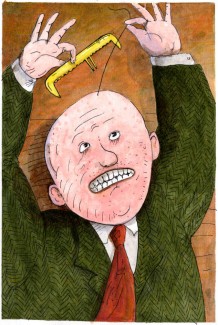 from Estonia. I hadn’t met Priit in the past at any festival. Id only seen about four or five of his films, but I have to admit that I’m not that big a fan. His work is somewhat chaotic and not really “character” animation. Stylistically, he never pulls me in and the substance is a bit too dense for me to the point of impenetrable. I always give the blame for such to myself for not being able to figure out what the filmmaker is trying to say, but when it happens with every one of the filmmaker’s films, I heed the warningand usually back away. That, I’m ashamed to say, is the case with me and Mr. Pärn’s films.
from Estonia. I hadn’t met Priit in the past at any festival. Id only seen about four or five of his films, but I have to admit that I’m not that big a fan. His work is somewhat chaotic and not really “character” animation. Stylistically, he never pulls me in and the substance is a bit too dense for me to the point of impenetrable. I always give the blame for such to myself for not being able to figure out what the filmmaker is trying to say, but when it happens with every one of the filmmaker’s films, I heed the warningand usually back away. That, I’m ashamed to say, is the case with me and Mr. Pärn’s films.
It was a pleasure meeting him, though. He’s truly a sweet man, and was very affable. I hadn’t heard in years from another Estonian, Rein Raamat, and was able to ask Priit if he knew what had happened to the older man. I knew he’d retired years back, but there’s only been silence, and I was afraid he’d died. No, it turns out he’s just retired. You could sense the discomfort there was in talking about the older man. Priit Pärn felt as though he were backing away while answering my questions. I imagine that’ll be the case when someone asks what had happened to me as I go off into the sunset drooling over my favorite Disney collectible.
The party Amid threw was great. A great crowd of people kept it entertaining, to say the least. John Canemaker & Joe Kennedy, George Griffin, Debbie Solomon, Candy Kugel, Emily Hubley with husband, Will Rosenthal, Leah Shore, Richard O’Connor, Liesje Kraai, and,of course, Celia Bullwinkle. There were, naturally enough, plenty of others, but these are they who pop into my mind as I write away.
Many thanks to Amid for hosting the fine event.
On Tuesday, The Princess Bride got a grand resuscitation from the New York Film
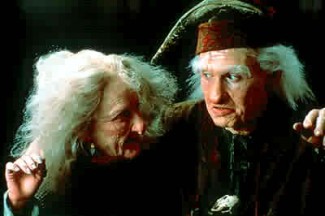 Festival as it honored Rob Reiner’s live action fairy tale. Actually it was an Academy reconstructed print, which is why I was invited. I’m not a fan of the film and had a hard time sitting through it again, but the Q&A was everything that night. On stage was director, Rob Reiner, writer, William Goldman, actors Cary Elwes, Robin Wright, Billy Crystal, Wally Shawn, Mandy Patinkin, Chris Sarandon, and Carol Kane. Rob Reiner was affable but slowly trned into a ham then a pig as he started to answer questions even when others were called upon to respond. He was oblivious to the audience laughing AT him at a couple of points. Billy Crystal, on the other hand, was truly funny. He kept everything moving smoothly with a great sense of humor. Mandy Patinkin was gracious honoring André the Giant the Giant who’d died in 1993. The hot spot was Cary Elwes who had a charming sense of humor with a number of funny bits.
Festival as it honored Rob Reiner’s live action fairy tale. Actually it was an Academy reconstructed print, which is why I was invited. I’m not a fan of the film and had a hard time sitting through it again, but the Q&A was everything that night. On stage was director, Rob Reiner, writer, William Goldman, actors Cary Elwes, Robin Wright, Billy Crystal, Wally Shawn, Mandy Patinkin, Chris Sarandon, and Carol Kane. Rob Reiner was affable but slowly trned into a ham then a pig as he started to answer questions even when others were called upon to respond. He was oblivious to the audience laughing AT him at a couple of points. Billy Crystal, on the other hand, was truly funny. He kept everything moving smoothly with a great sense of humor. Mandy Patinkin was gracious honoring André the Giant the Giant who’d died in 1993. The hot spot was Cary Elwes who had a charming sense of humor with a number of funny bits.
The afterparty was a bust. Loud, overcrowded and irritating it didn’t take long for me to leave. They sent us away with a Goody Bag that included a book of the script filled with scrap from the film lots of stills, artwork of the sets and plenty of information if you’re a fan. They also gave us a T-shirt and as well as a Blue Ray copy of the movie. (I still don’t have a player) I was pleased to give away the bag to someone who really appreciated it.
 Wednesday was the height of the week – a TV night. The Yankees were playing for the championship of the AL East. If they won they got it; if the lost and Baltimore won they were just a team with a one-game playoff to go on Thursday. Yankees won, Baltimore lost.
Wednesday was the height of the week – a TV night. The Yankees were playing for the championship of the AL East. If they won they got it; if the lost and Baltimore won they were just a team with a one-game playoff to go on Thursday. Yankees won, Baltimore lost.
Then the highlight of the night. The first Presidential debate aired from Colorado. Romney got the chance to look Presidential as he stood alongside the real President. The format went out the window as Romney ignored Jim Lehrer and fought him time after time after time. Obama curled up into a ball and didn’t fight for what he believed in. Romeny just kept lying and changing his opinion on everything. He’s been politicking on a tax cut for the rich these past 9 months, now he says that that’s not what he’s doing. I give up. Obama just stood there with his head down taking notes, for some reason. I got so frustrated by his performance that I was about ready to change the channel.
At least the Yankees knew how to win.
Thursday saw two films: The Paperboy starred Matthew McConaughey, Zac Efron, John Cusack, and Nicole Kidman. Lee Daniels directed his second film. (Precious was his first two years ago.) This film was a mess and tried so hard to be an artfilm. Trashy characters mix with each other until half of them are dead. Macy Gray was one of the only spots of dignity in it.
and
The Eye of the Storm is an Australian film starring Geoffrey Rush, Judy Davis, and Charlotte Rampling. It was directed by the pro, Fred Schepisi. This was a very well acted film. Judy Davis was near brilliant even though the script wasn’t as strong as it might have been. I really found enjoyment with the interplay of the characters and the actors who inhabited them.
I saw Bill Plympton at this screening and invited myself to his loft to say hello to his newborn baby boy. I’ll try to make it there this week.
Lots of screenings and parties and whatnot are on the schedule for the next week or so. I’m amazed with how much the Academy has been involved in the New York Film Festival this year. I’m also pleased with it.
Frankenweenie Reception
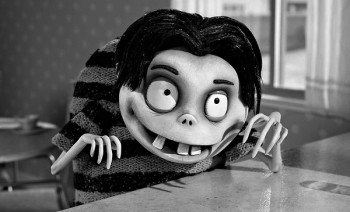 Frankenweenie opened in NY yesterday, though I won’t get to see it until next Thursday (and will review it after I see it.) The film received some of the best reviews this year for an animated feature. Nationally, Rotten Tomatoes gives it an 85% rating.
Frankenweenie opened in NY yesterday, though I won’t get to see it until next Thursday (and will review it after I see it.) The film received some of the best reviews this year for an animated feature. Nationally, Rotten Tomatoes gives it an 85% rating.
Elizabeth Weitzman in the NYDaily News gave it four **** stars and called it a “Frankenweenie Delight.” The lst lines of the review are: “Despite the gently macabre tone, there are no gratuitous scares or elbow-nudging ironies. Just a witty, warm appreciation of cinema, science and the creativity of childhood.
___________________________________________What a rare and welcome treat.”
A.O. Scott in the NYTimes praises the film lightly but pulls back at each bit of praise. “The delights of “Frankenweenie†are abundant and real. Its opening scenes are beguiling in their strangeness, and its climax is wild and hilarious. But the movie, a Walt Disney release, also feels tame and compromised, a tissue of safe pop-culture allusions rather than an inspired, audacious engagement with older movies.”
Lou Lumenick in the NYPost gives it 3½ stars and fine praise. “‘Frankenweenie’’ is Tim Burton’s best film in years. With this expanded, beautifully realized and highly entertaining animated version of his famous 1984 live-action short about a young loner and his resurrected dog, Burton, whose films have gotten progressively more overblown and overproduced, goes back to ghoulish basics. It’s an endearingly modest and affectionate tribute to the classic 1930s monsters and their influence on daydreaming kids like Burton who grew up in suburbia four decades later.”
The Village Voice‘s Chris Packham has only high tribute to the film. “Frankenweenie Awakens the Pleasures of Reanimation” “Frankenweenie . . . is tight and brief, hitting all the marks you’d expect from an animated kid’s film, and enlivened by Burton’s visual style. The man should make more small movies like this one.”
One wonders what will happen to Adam Sandler‘s successful feature, Hotel Transylvania. (Interesting that I instinctively tought of this as Adam Sandler’s film and not Genndy Tartakovsky‘s film.) Will Frankenweenie kill this or vice versa? We’ll know by Sunday.
Hubley Films
- There will be an extensive program of Hubley films screened at The Museum of Arts and Design on Friday, Oct. 19th. The films to be screened are a large mix of those done by John, Faith and Emily Hubley. They include:
- Adventures of an Asterisk
1957, Dir. John & Faith Hubley
The Hat
1964, Dir. John & Faith Hubley
Eggs
1971, Dir. John & Faith Hubley
Cockaboody
1973, Dir. John & Faith Hubley
The Tender Game
1958, Dir. John & Faith Hubley
Time of the Angels
1989, Faith Hubley
Her Grandmother’s Gift
1995, Dir. Emily Hubley
Witch Madness
2000, dir. Faith Hubley
Pigeon Within
2000, dir. Emily Hubley
Northern Ice Golden Sun
2001, Dir. Faith Hubley
Set Set Spike
2002, Dir. Emily Hubley
And/or
2012, Dir. Emily Hubley
details:
The Museum of Arts and Design
2 Columbus Circle, New York, NY 10019 on
Friday, October 19, 2012 – 7:00 pm
$10 general / $5 members and students
New Savannah

A photo by Bill Benzon which seems to work exquisitely on his site.
- Bill Benzon continues with some of the most intellectual theses and conversations on his blog, the New Savannah. Recently, I directed you to a lengthy piece about Dumbo which Mr.Benzon had reworked into a PDF which was available for the clicking.
Lately, he has written about many big concept ideas such as the lack of cartoon animals as a stand-in for humans in modern animation. Where’d the Animals Go? discusses this subject in earnest. From South Park to UP to the Simpsons to Brave, humans dominate. Animals are animals, as in How to Train Your Dragon.
He’s written about Cuteness (the Infant Schema). An analysis of Tweety and other big-headed, big eyed, sweet characters.
He’s written about Ratatouille and the discussion of man, vermin and food. This has stretched on to three nice-sized posts. In fact this is the heart of this film, and it’s quite adroit of Bill Benzon to go directly to that place to discuss the subject. This, it seems to me, is what he often does.
It’s also what makes his blog a regular read for me. (I also love many of the photos he posts along the way.) This is a site unlike any other. Intelligent conversation about cartoons. No, it’s not about how many lines Bugs Bunny ahs on the back of his gloves from cartoon to cartoon, but it talks about the abstract. Considering that all cartoons and cartoon characters are abstractions, it’s interesting that there are no others like this blog.
I’ve had a rare few of my films given the intellectual approach in reviews. A scholar of Hans Christian Andersen‘s tales delved deeply into a number of my updated Andersen tales and he gave them a quite positive review in his two books on the subject. These were done without my knowledge; I learned of them only when a reviewer’s copy arrived in the mail compliments of the author. I have to say these are the reviews I most treasure. The analysis of the thoughts that went into the films. Someday, perhaps, Bill Benzon may take some interest in my work. (hint, hint)
Animation Artifacts &commercial animation &Layout & Design 03 Oct 2012 06:46 am
I want my MTV
- In searching through the archives of work at Buzzco, where Vince Cafarelli‘s collection is housed, I came upon some MTV artwork. Some of you may remember that MTV had some wild art bumpers when they first started out. Buzzco did the lion’s share of these early logos. Candy Kugel did the artwork for them, and Vince Cafarelli wasn’t involved. These were done when Perpetual Motion was breaking up and Buzzco was coming into being. Buzz Potamkin would pull Candy into another room and give her the new assignment so that no one at Perpertual knew what she was up to. Once the split happened, Buzzco kept the account.The colors have deteriorated a bit in some of these. I’ve done some minor photoshop adjustments to brighten the colors a bit.
But first let me show some rough sketches for the very first promo for MTV in 1982. This came before the MTV campaign, “I want my MTV.” I vaguely remember this, but am not sure of it. I wasn’t a confirmed MTV watcher in those early days.
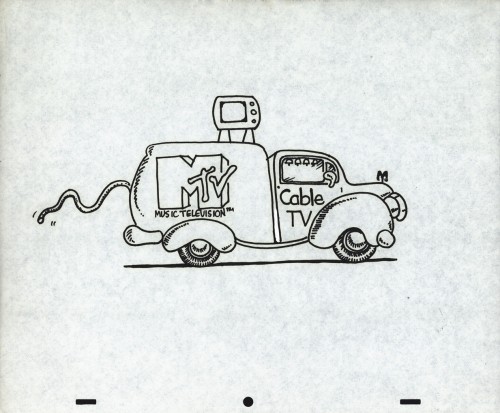 1
1Drawing by Candy Kugel
Here are eight of the color pieces. I’ll display two versions of each setup: the full artwork first, then the screen-sized art following so that you can see the proper framing.
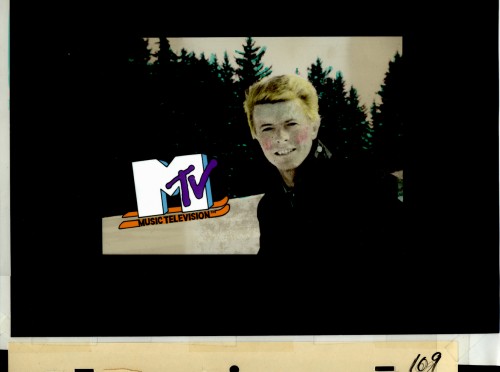 1a
1aDavid Bowie
Animation &Animation Artifacts &commercial animation &Layout & Design 26 Sep 2012 05:15 am
Vince Cafarelli’s Millbrook Bread – 2
- Last week we saw the first of these two spots Vince Cafarelli did while working for Goulding-Elliot-Graham Prods., Inc. Millbrook Bread was the client and the Piels Bros. voices, Bob Elliott & Ray Goulding, owned the studio with Ed Graham. They also did the voices for these bread spots. This particular one must have been pretty big; the video survived these many years later, and I’ve attached it to the end of this post.
But first, here are the Layout drawings which I believe were done by Vinnie Cafarelli.
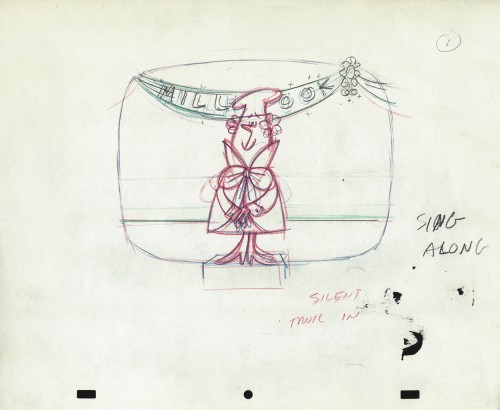 1
1
